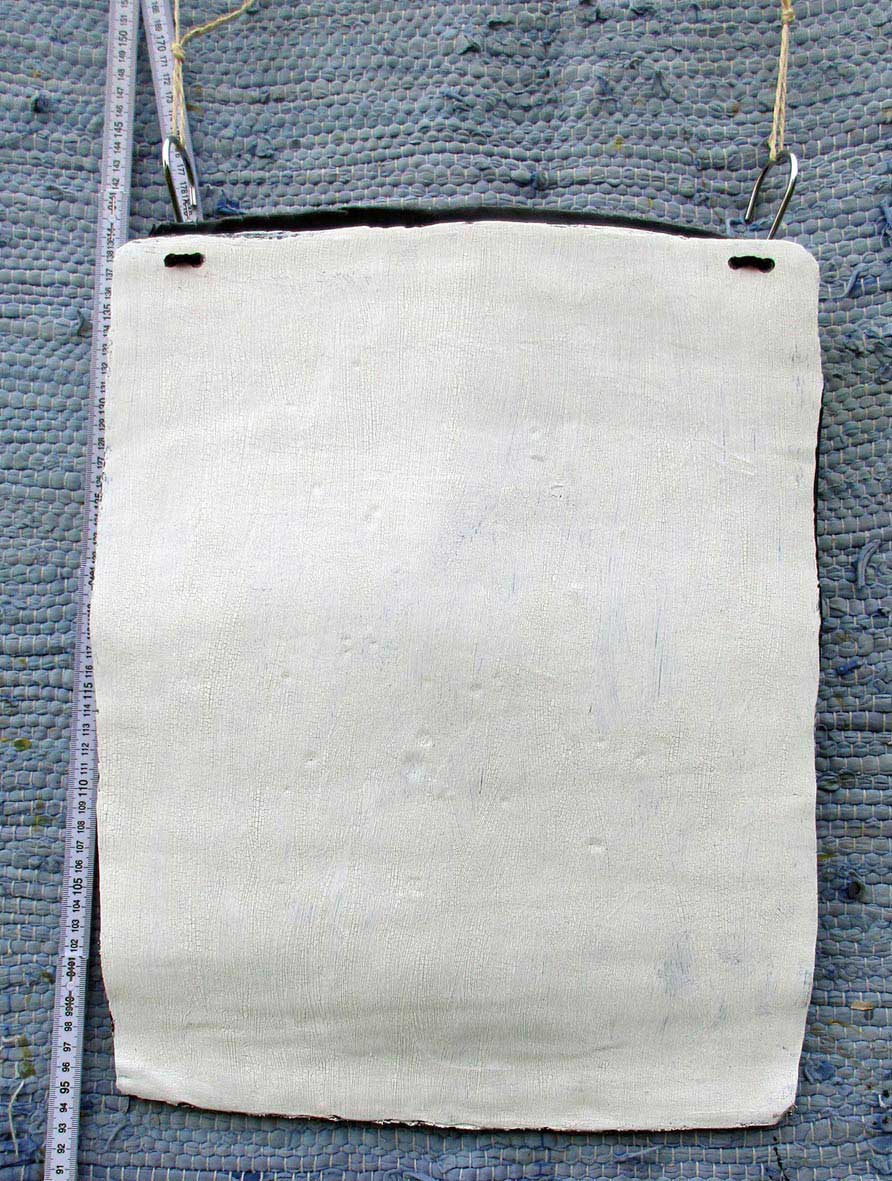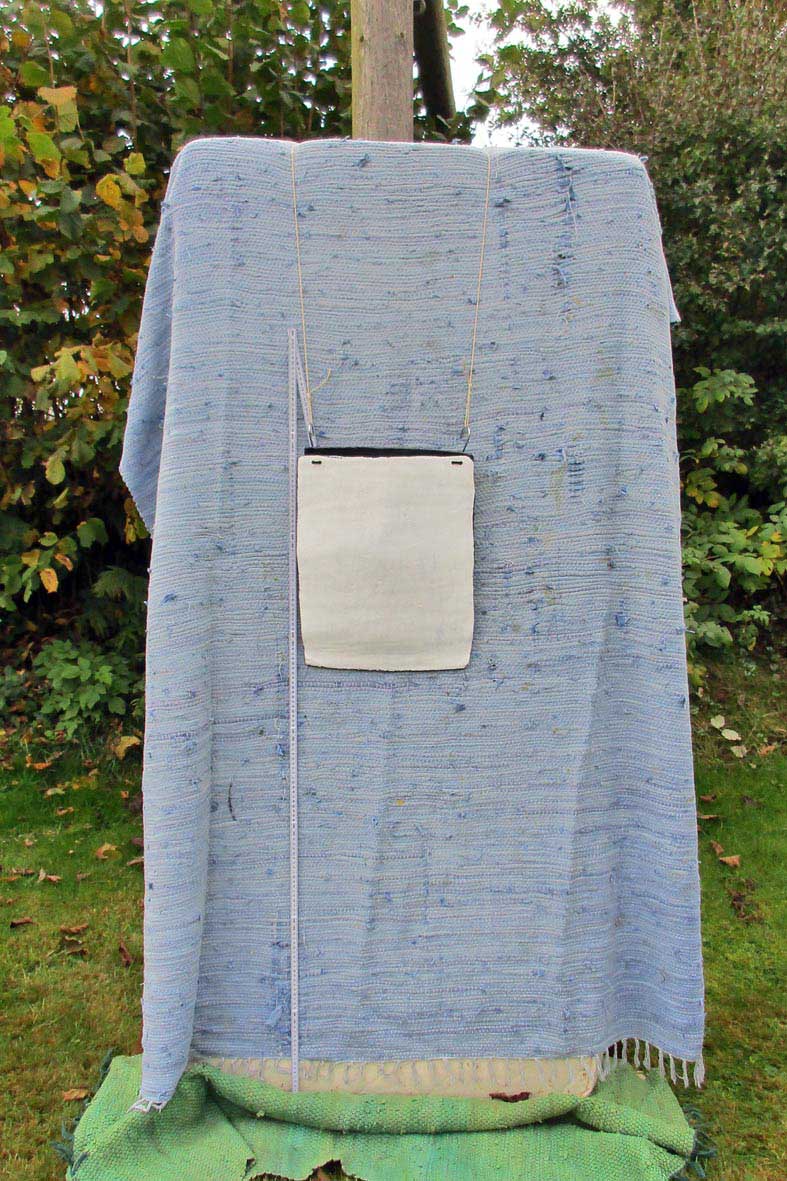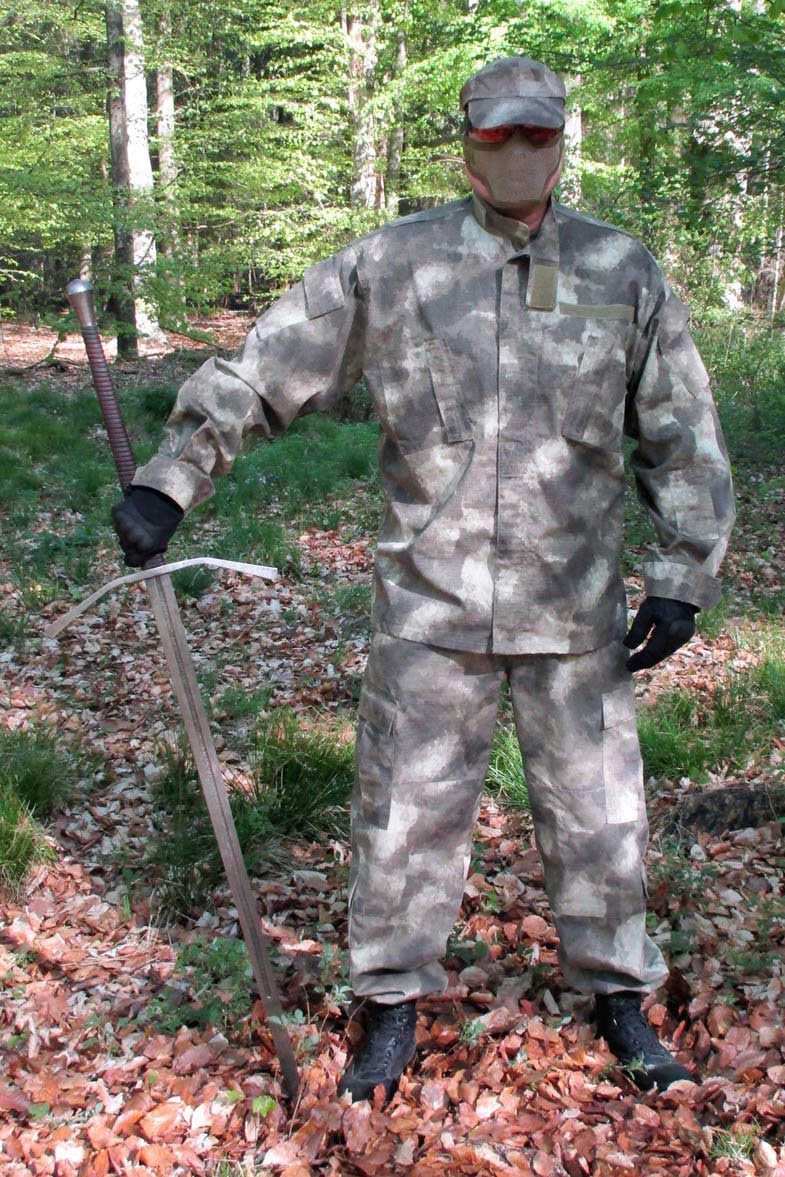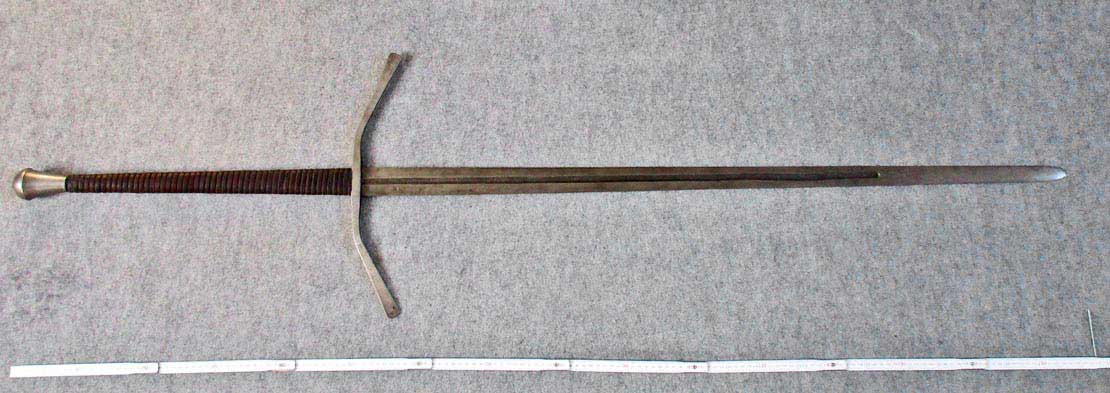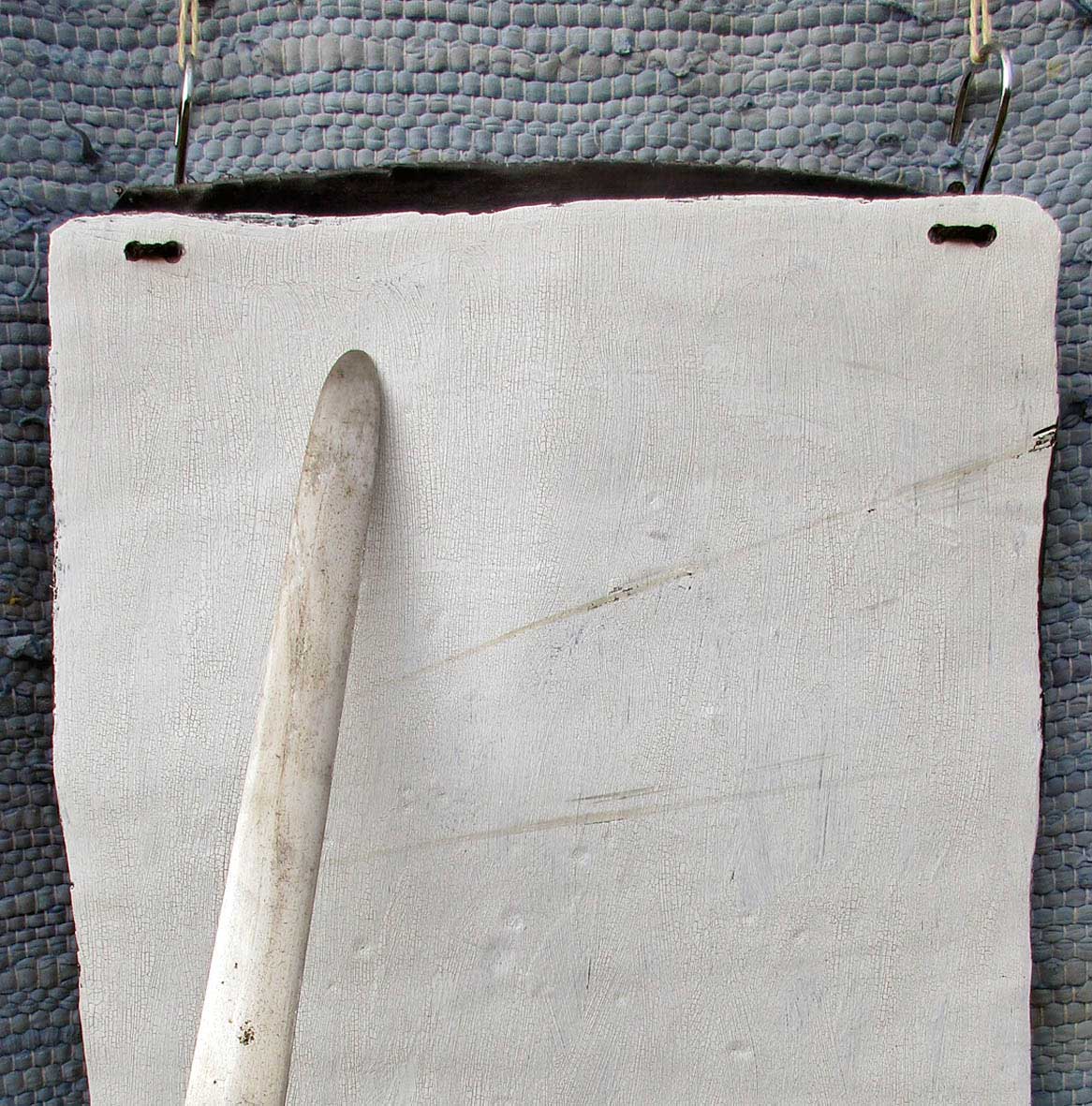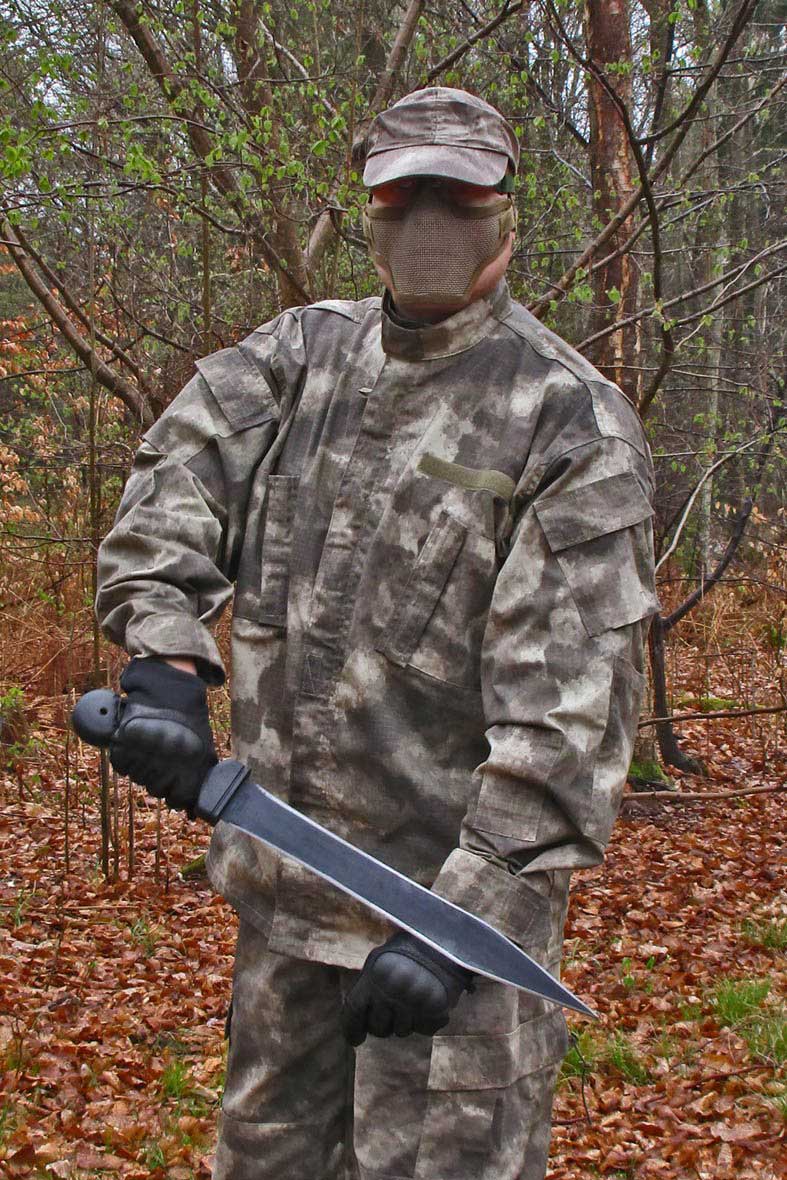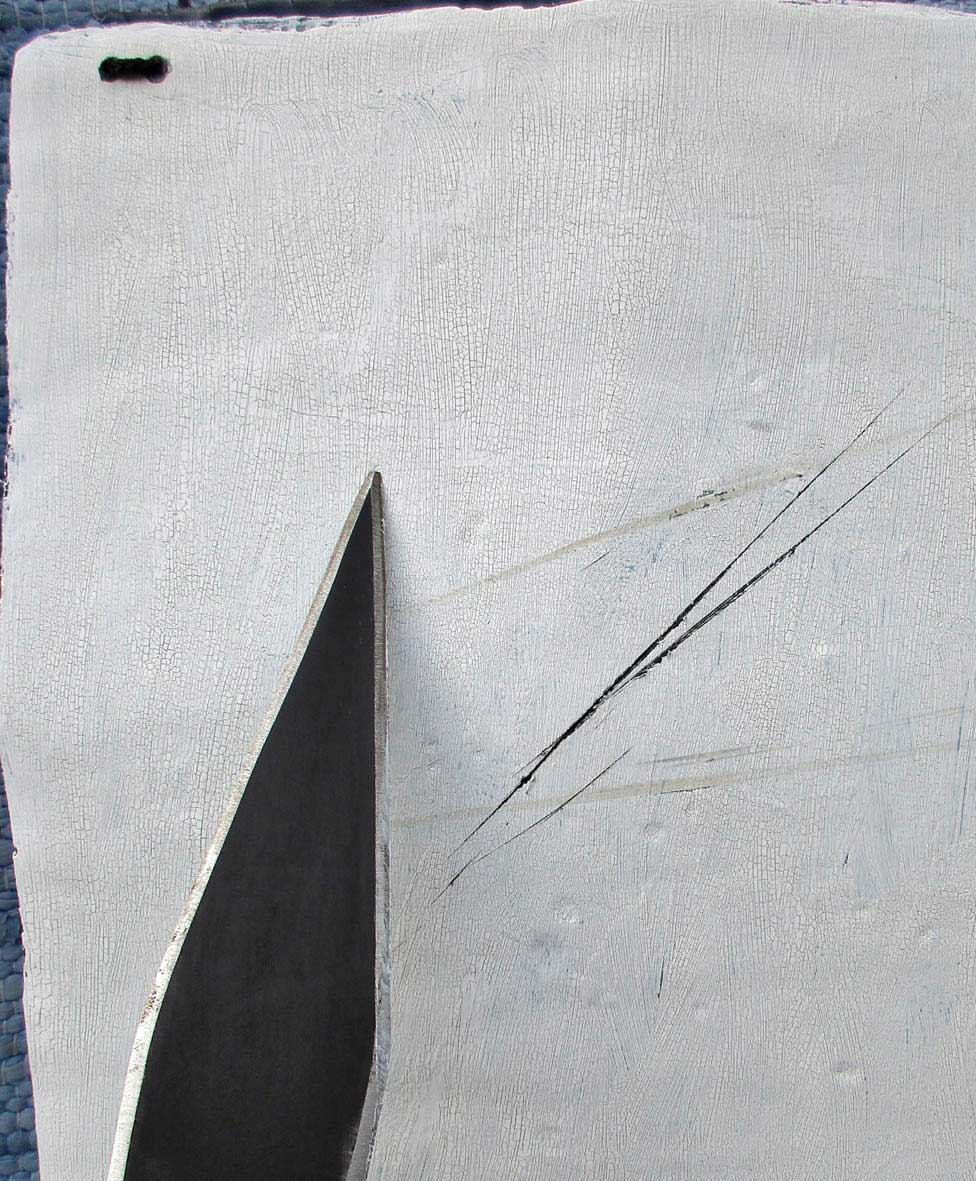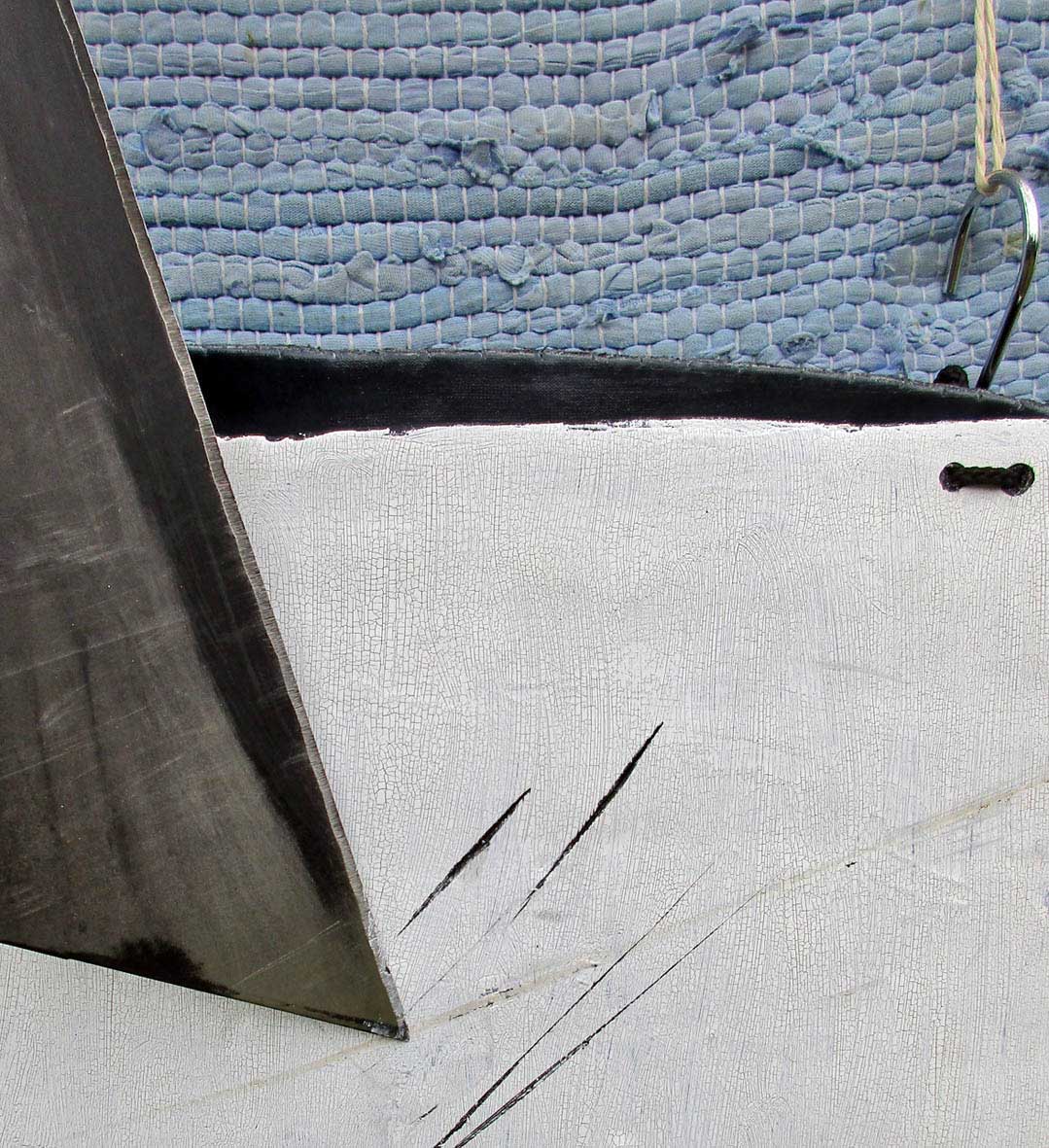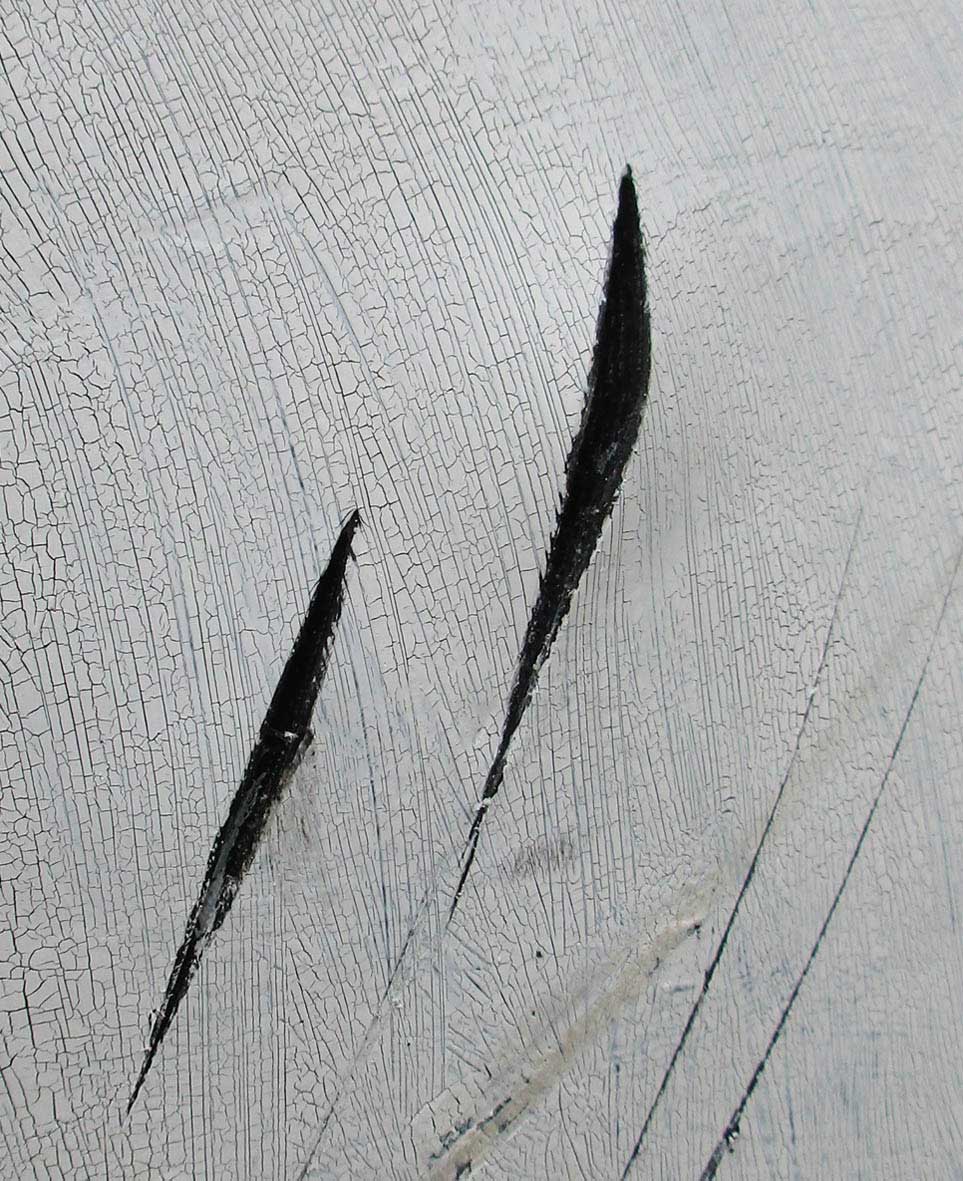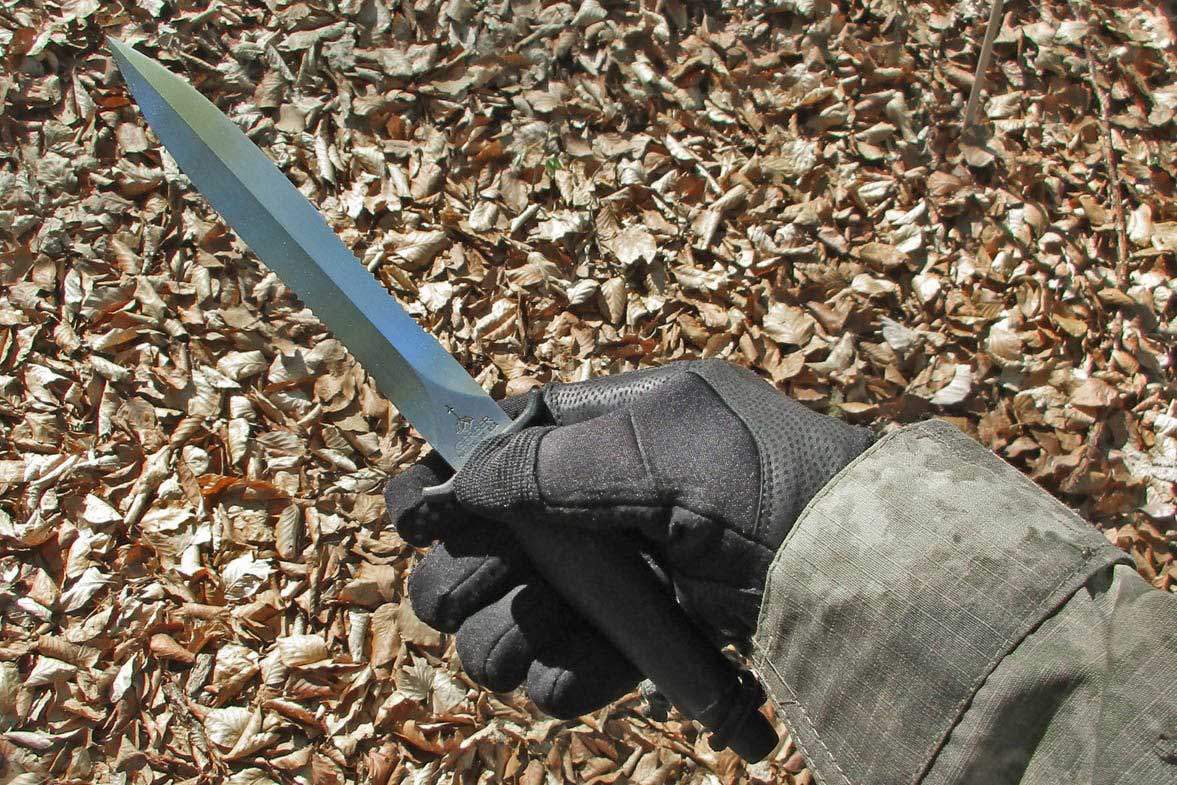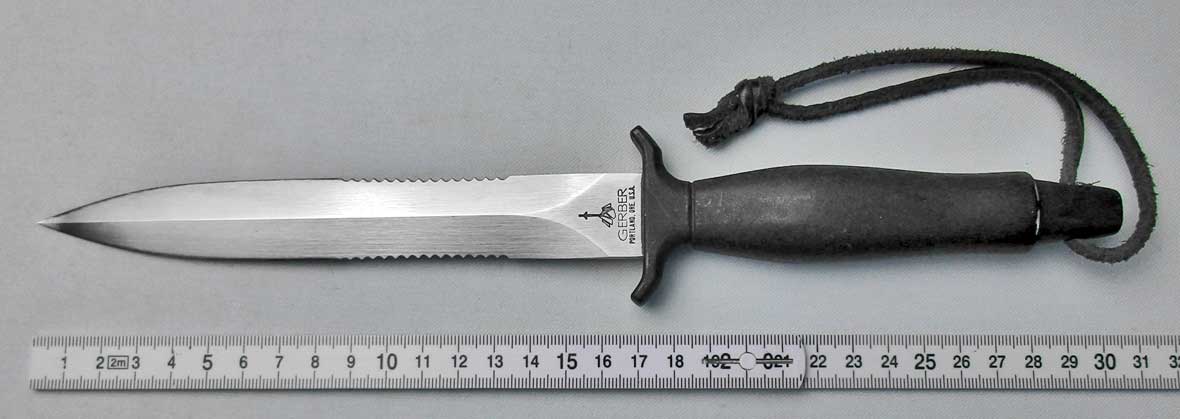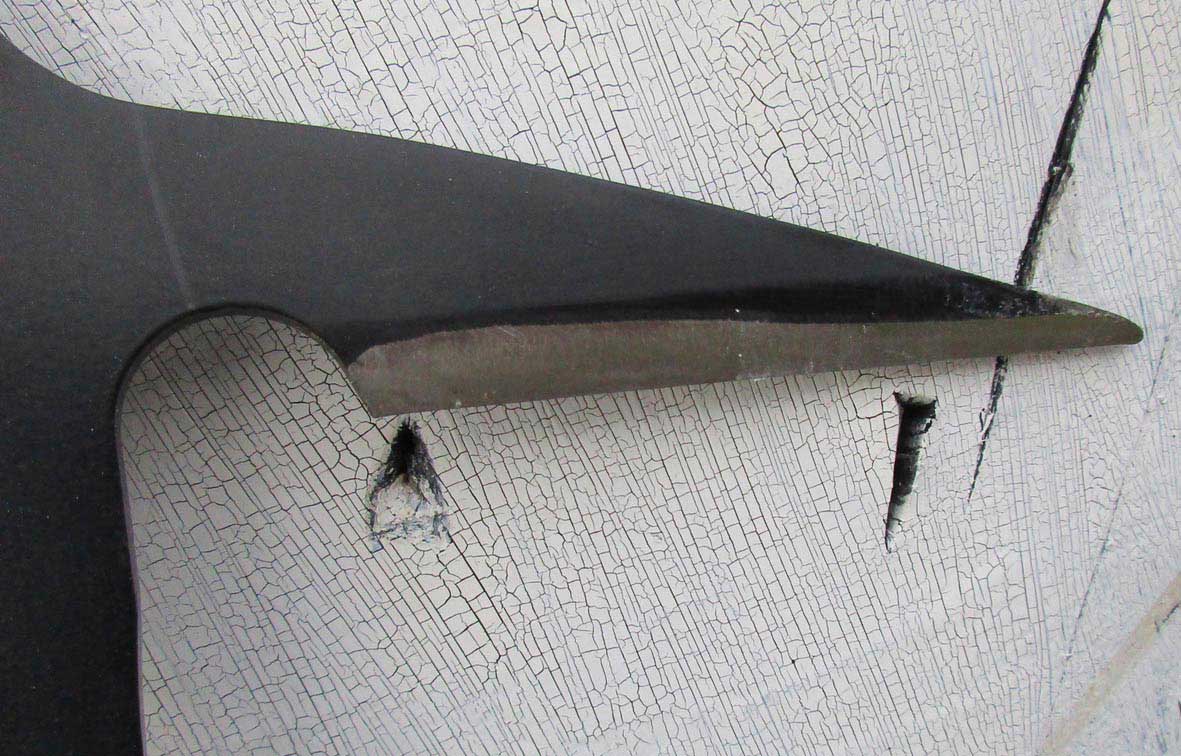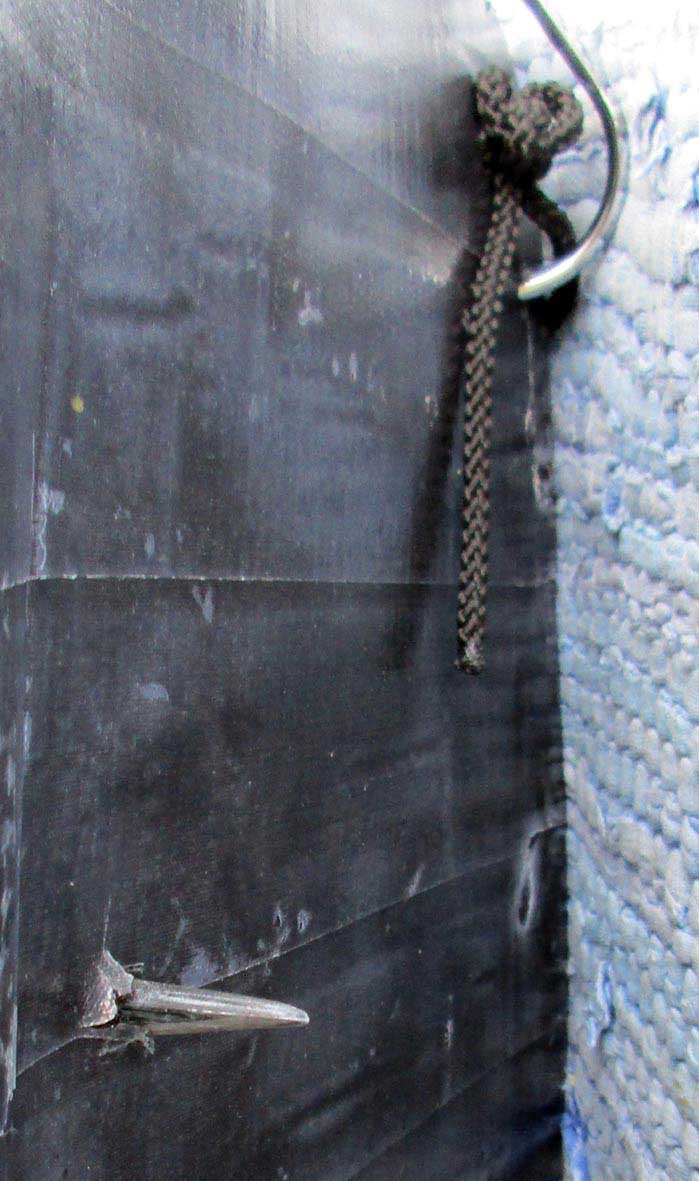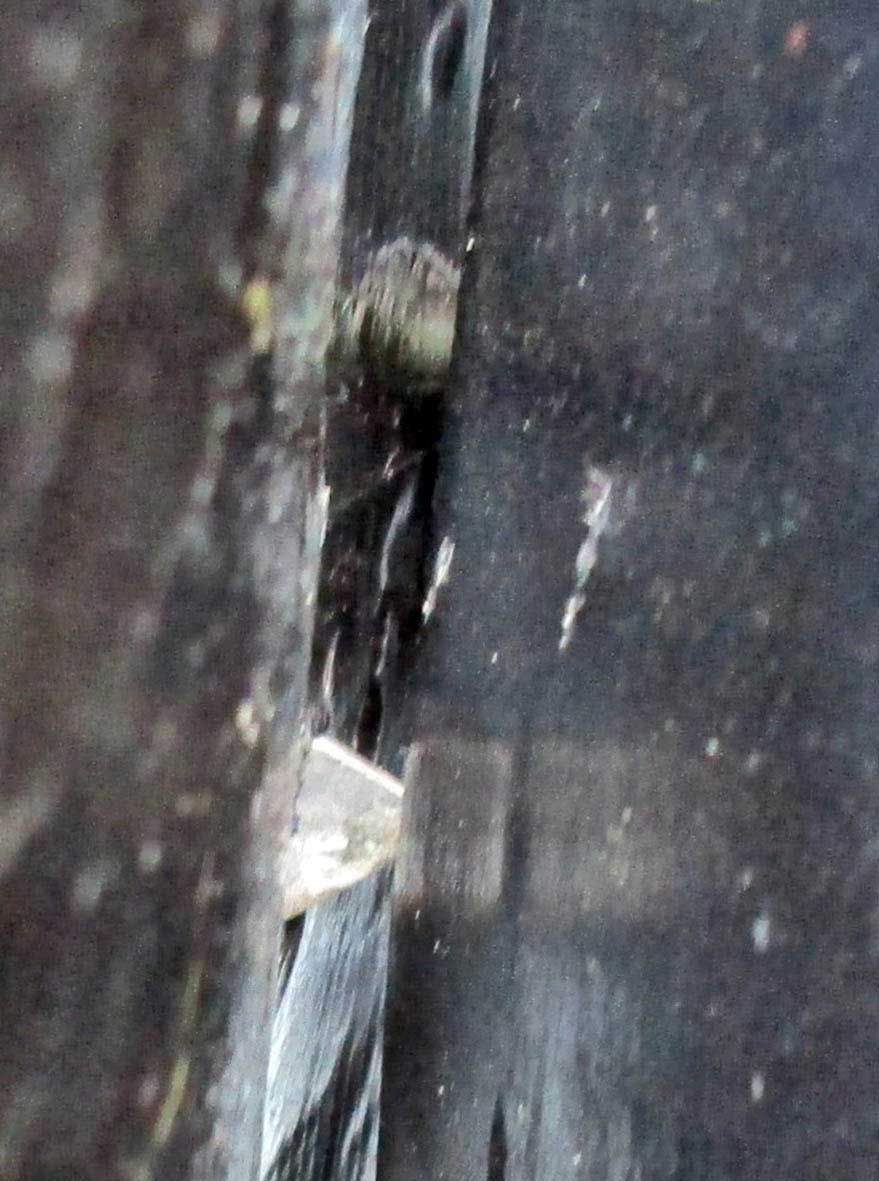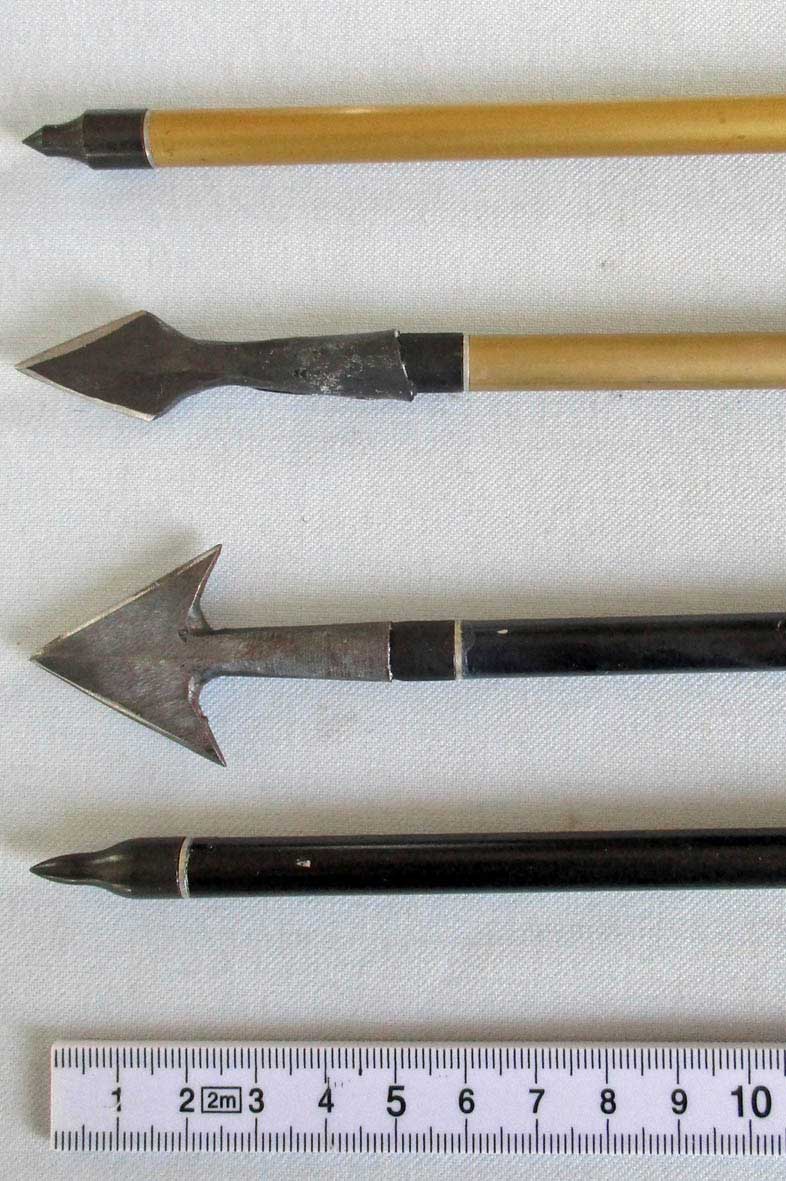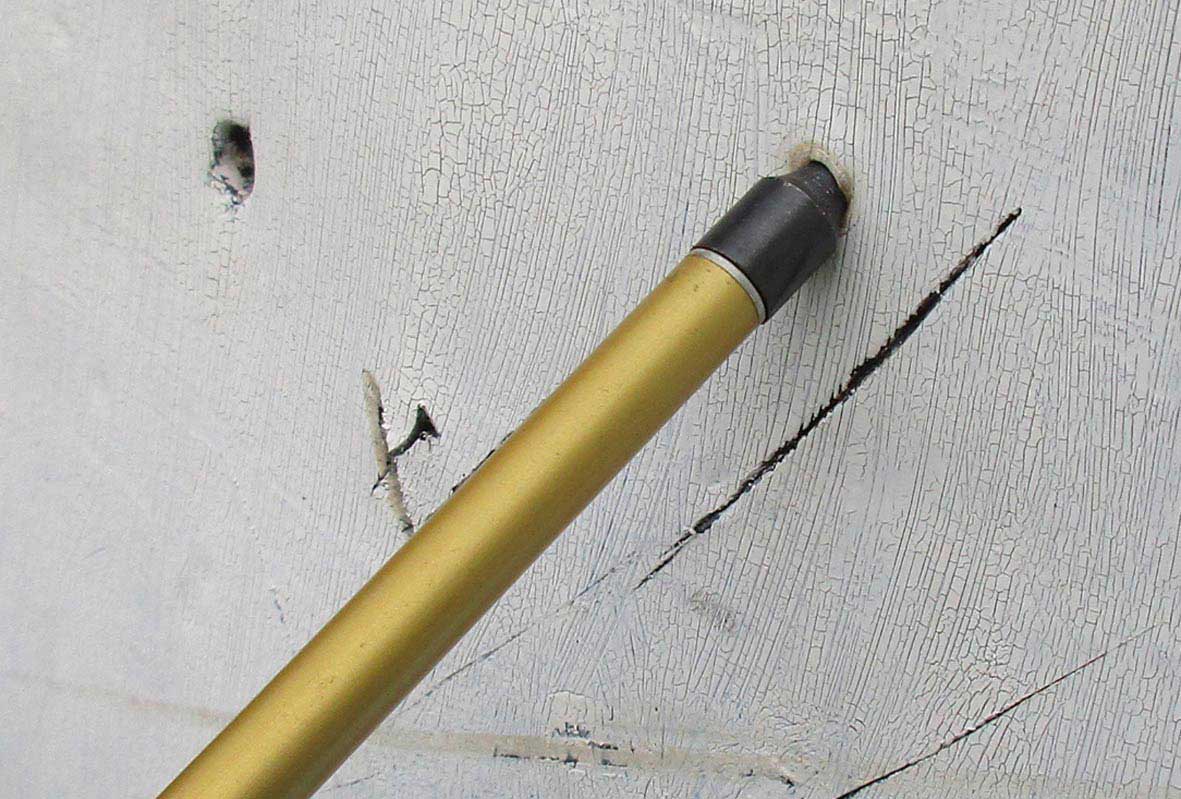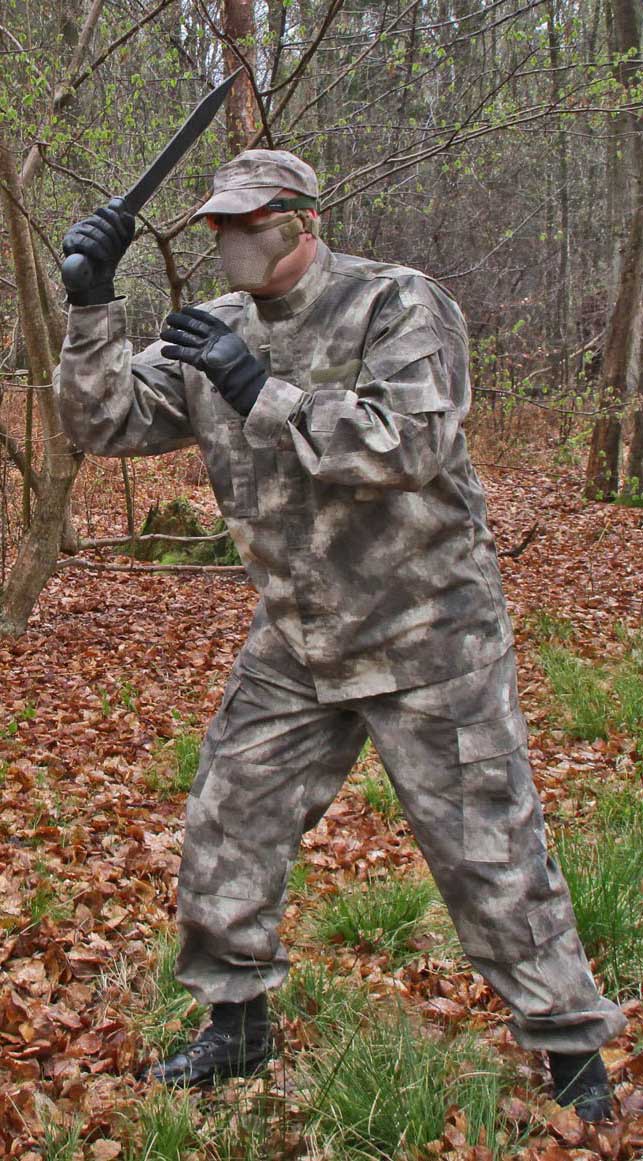|
|
|
This page belongs to the subject area “linothorax”. The beginning would be here: composite armour. The test only appears in the english section of the website. Yes, I know, another one... as if the internet wasnīt full of “tests” of cloth- glue- composite artefacts already. |
 |
|
A linothorax will not protect you against modern firearms but is very useful in every conflict that doesnīt involve gunpowder. So letīs first see what can happen in a low- tech- battle: Hits, slashes and stabs A hit here means that either an edged or dull object strikes in a way that the first third of the blade (or stick) is used (mono- uchi). An unprotected limb that is struck that way by a sharp blade might even be severed. Also a mace- hit or a strike with a stick where the blunt head of the weapon deliberately is used would fall into this category. A slash would be a hit where only the point of an edged weapon strikes a kind of glancing blow, opening a wide, deep gash. This technique is very well suited for short swords or axes because it lessens the chance of a blade getting stuck- never a good thing in a fight. And a stab is where a point (either that of a sword or dagger, spear or arrow, but also the end of a stick) makes contact, concentrating a lot of energy on a very small area, thus eventually piercing the target or causing blunt trauma. For the test Iīve chosen cutlery capable of delivering all of these inconveniences and am really curious about the result. In the pictures below the hardwareīs various attributes are discussed. Youīll also get subjected to a certain dose of equipment- talk (which is another one of my many bad habits), but I somehow feel that one shouldnīt just write: “... and then I hit it repeatedly with a damn big sword.” Working with weapons requires special safety precautions from “safe environment” to “adequate equipment”. Donīt study for yourselves but find a professional teacher. This test took over a year to arrange and I canīt wait to start; besides, timeīs running out. But first of all: the target. |
|
|
|
|
Now however itīs the end of october and the time window for photographs closes: autumn temperatureīs 15 °C / 59 °F and tomorrow itīs gonna rain. So- to arms! |
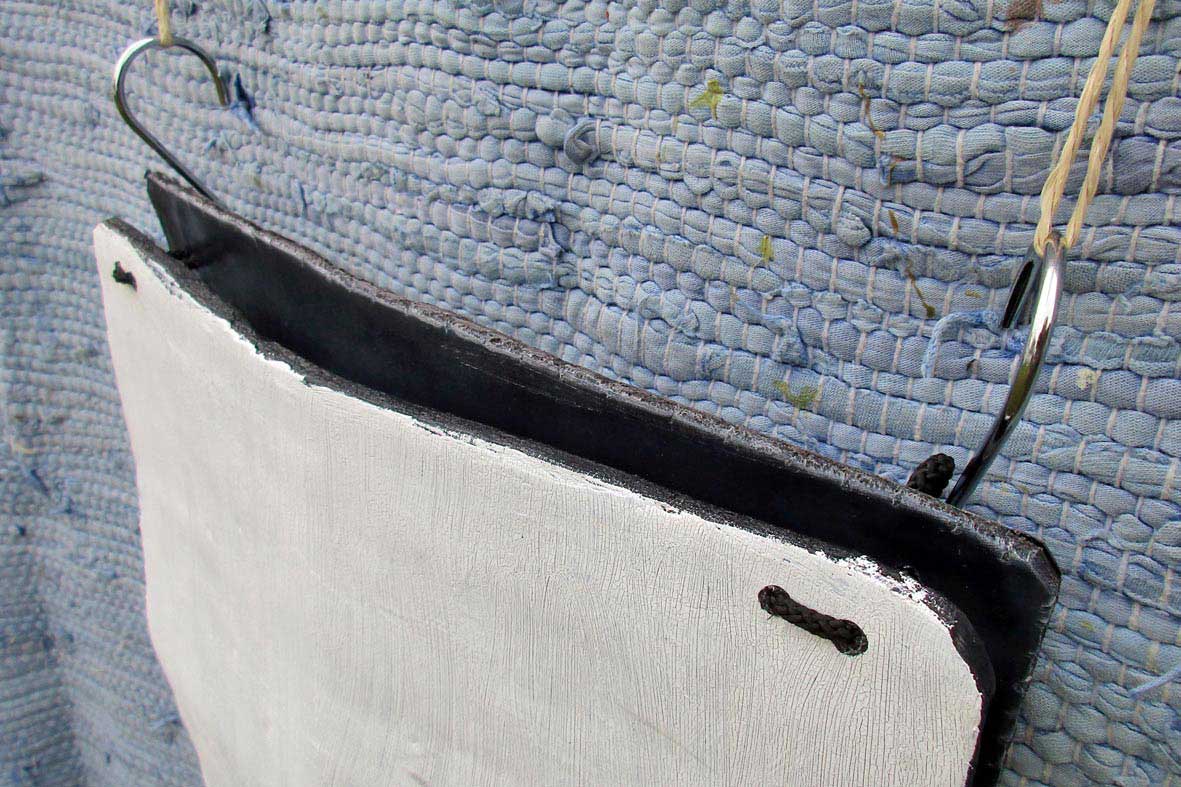 |
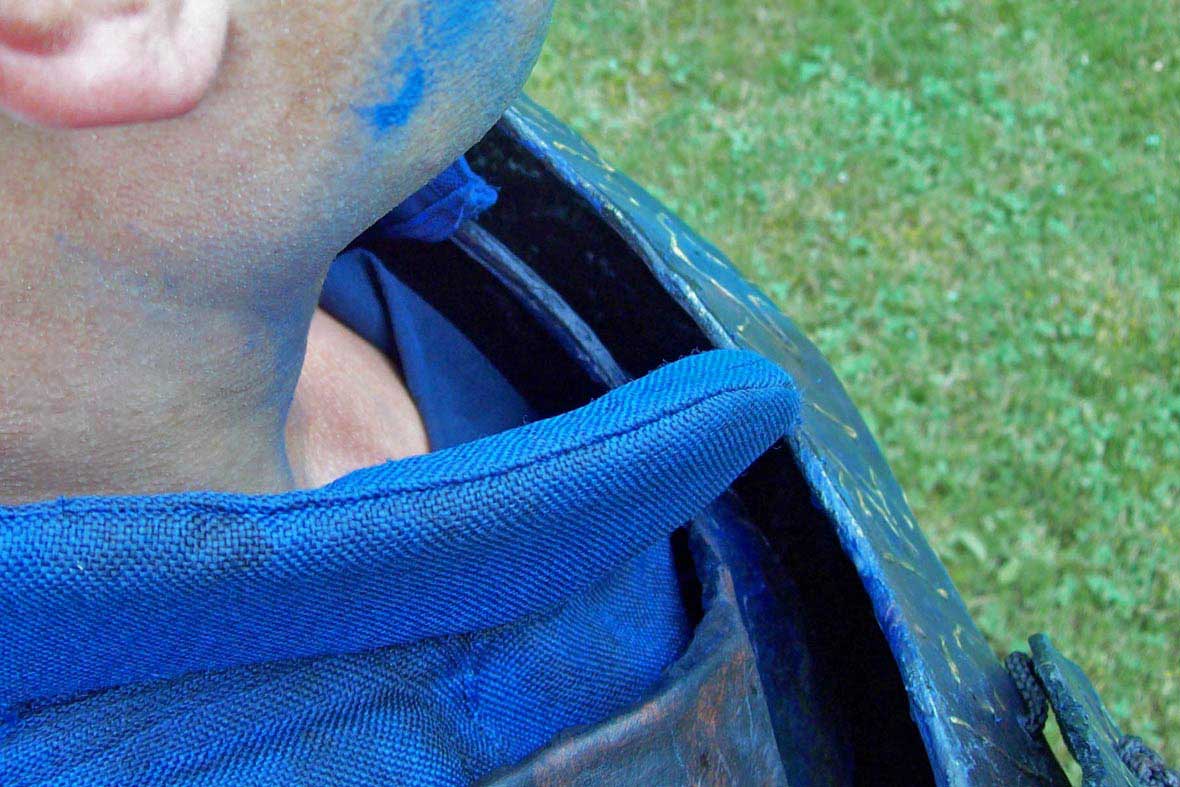 |
|
above: The targetīs plates are laminated together at the bottom but open at the top like my armour (which is stabilized by its collar construction while the targetīs plates are held apart by the hooks). Hopefully some energy is eaten up when the impacts press the layers together. It was made of black cotton linen, then painted white to better show hit marks. Time to find out what it can take; let me introduce the first candidate: |
|
|
||||||||||||||||
|
|
||||||||||||||||
|
|
|
Ok, letīs try a sharp short sword next: |
|
|
||||||||||||||||||||||||||||||||||
|
|
|
Next on the agenda would be a slash; a striking hit with the tip of a sharp blade. This time I donīt use a weapon but a tool: |
 |
 |
|
above: The “light machete” (cs97lm), also made by Cold Steel. Designed for putting maximum weight into a strike, a chopping knifeīs balance point -contrary to that of a sword- is not by the handle but almost in the middle of its total length. |
|
|
|
|
Again: I expected this result. Let me stress once more that it is not the fault of the blades: their quality is such that I would trust them in a crisis- but a strike either with momentum, edge or sharp tip is not sufficient to overcome this type of armour, as already the ancient greek knew. But composite is not invulnerable- there should be ways to punch a hole into the stuff. What about a good stab? |
|
|
||||||||||||||||
|
And another one of the many warnings on this page: |
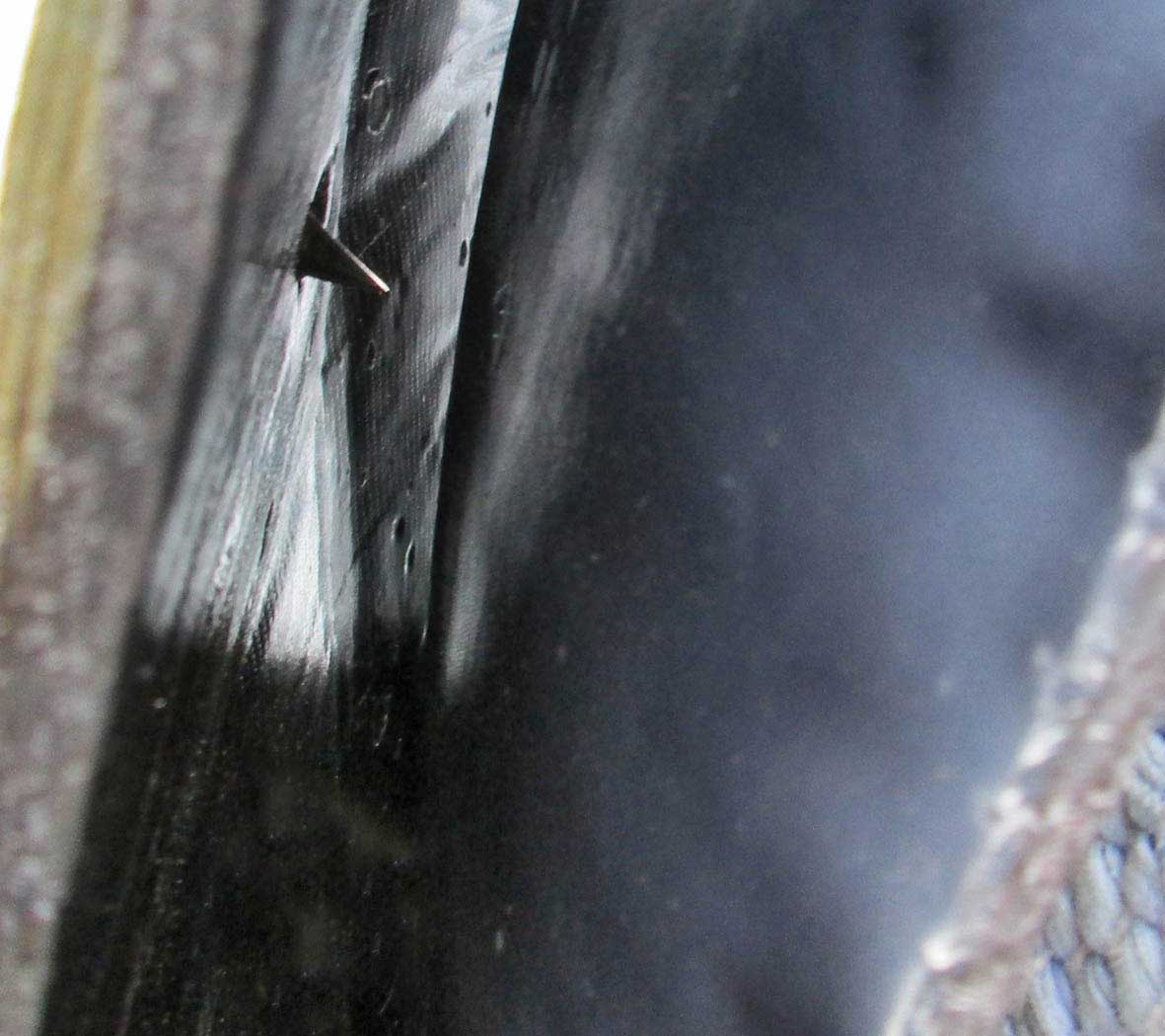 |
|||
 |
|||
|
above: Well, I never said cloth/ glue- composite was undestroyable, did I? (checks rest of the websiteīs linothorax- area inconspiciously)... The dagger penetrated the first layer about a centimeter without nicking the second tier. Not bad, but not dangerous also. As an interim result I may postulate that my armour- concept has perfectly good resistance value against 90 per cent of the weapons one presumably will meet on a low- tech- battlefield. But there should be more means of punching through armour... For the next round weīll see how the target fares against a hatchet: |
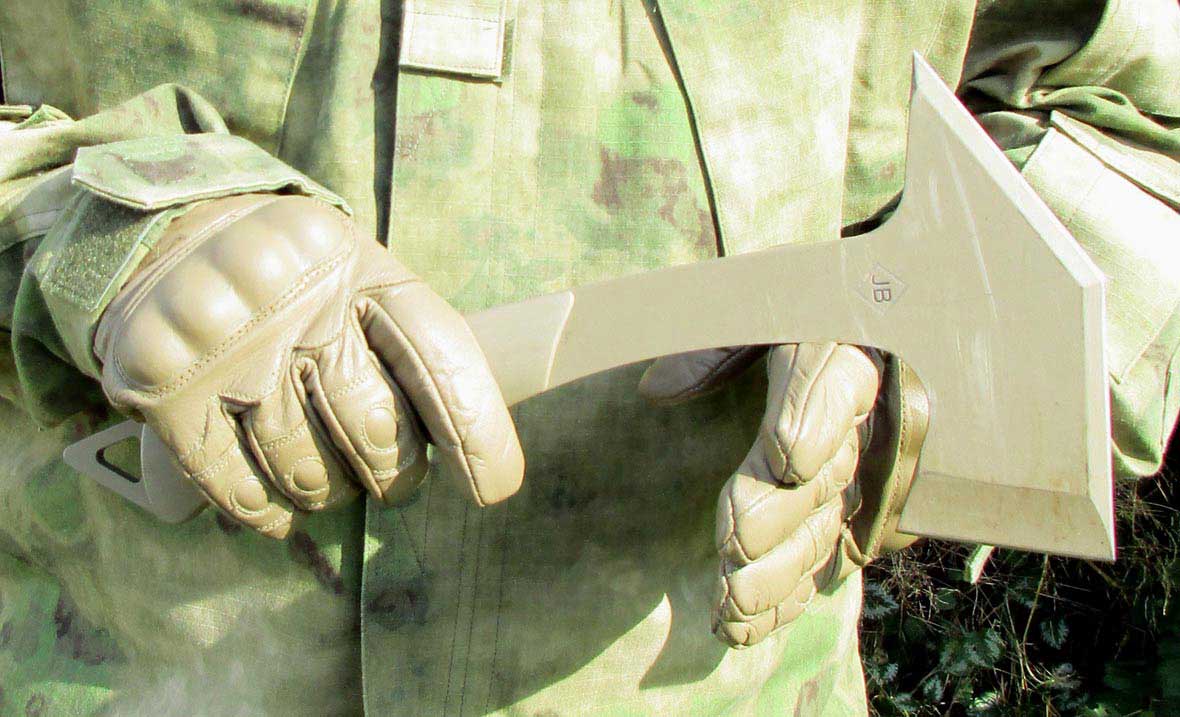 |
|||
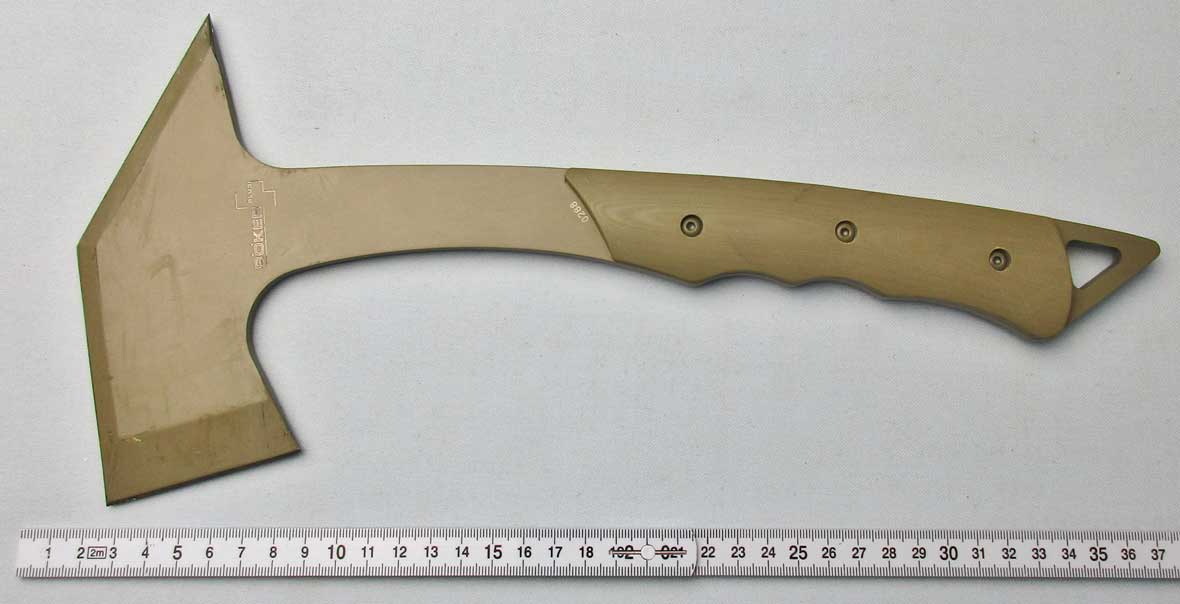 |
|||
|
above: “Carnivore” by Böker (a well- known german manufacturer of quality cutlery) is not a weapon as such but a crash-tool for urban warfare; which translates as “a compact firemanīs axe for soldiers who now and then have to break into houses”. |
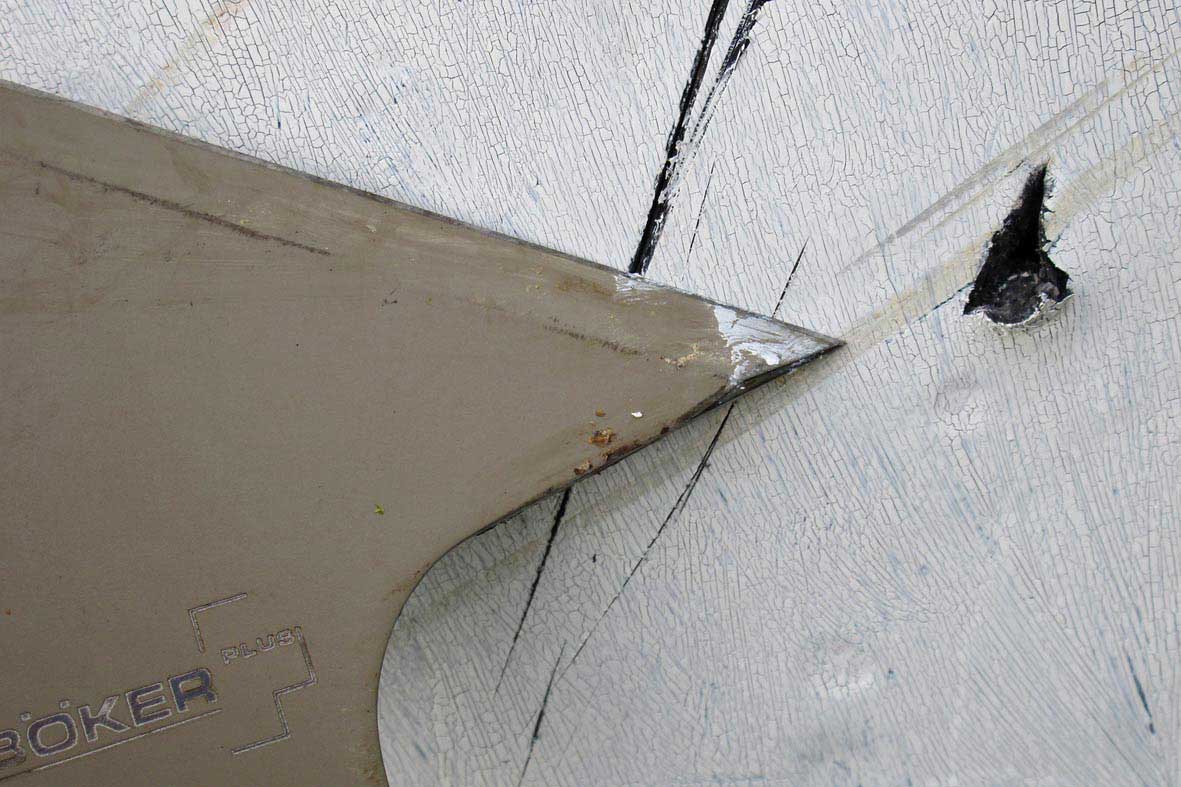 |
||||||||
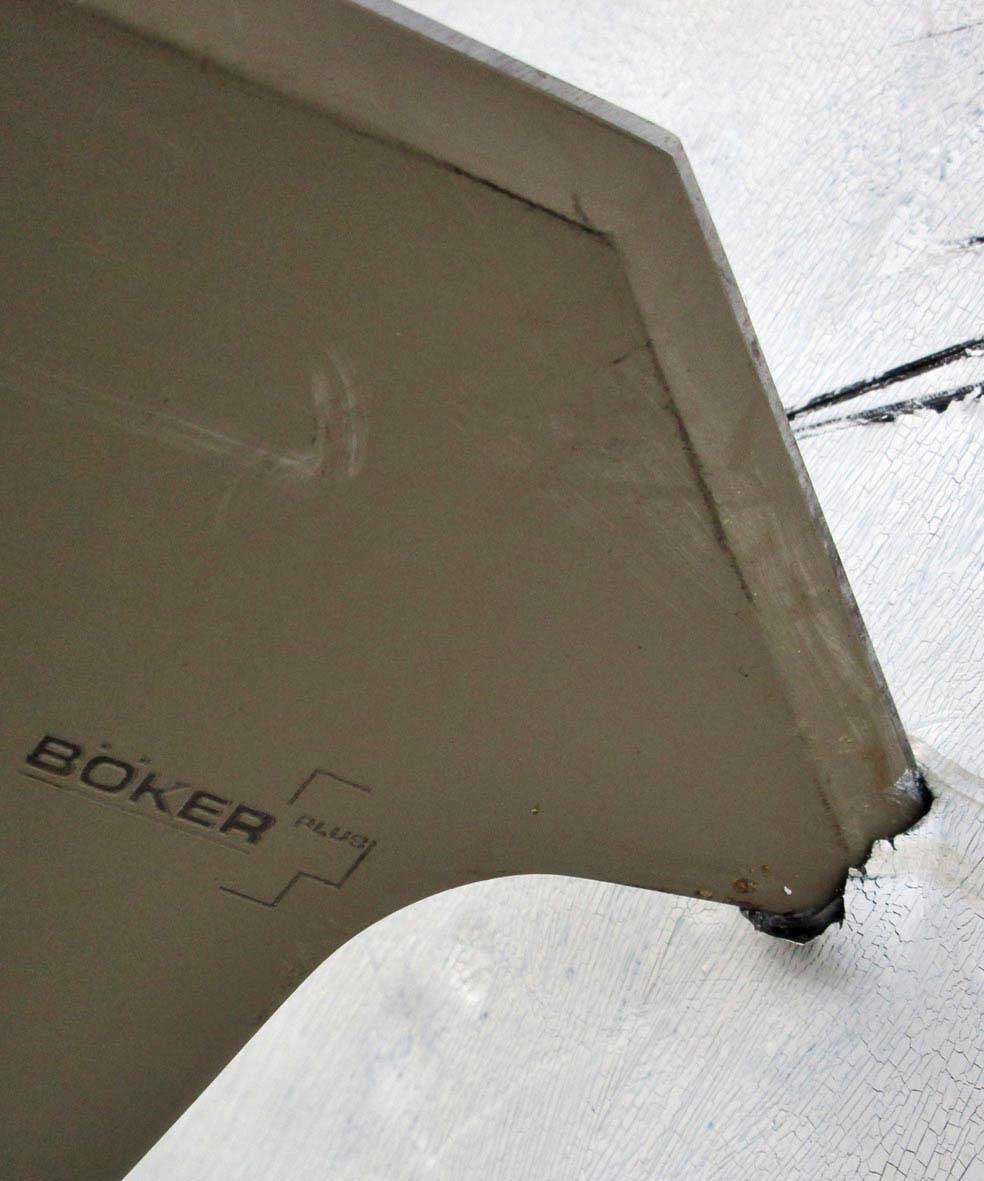 |
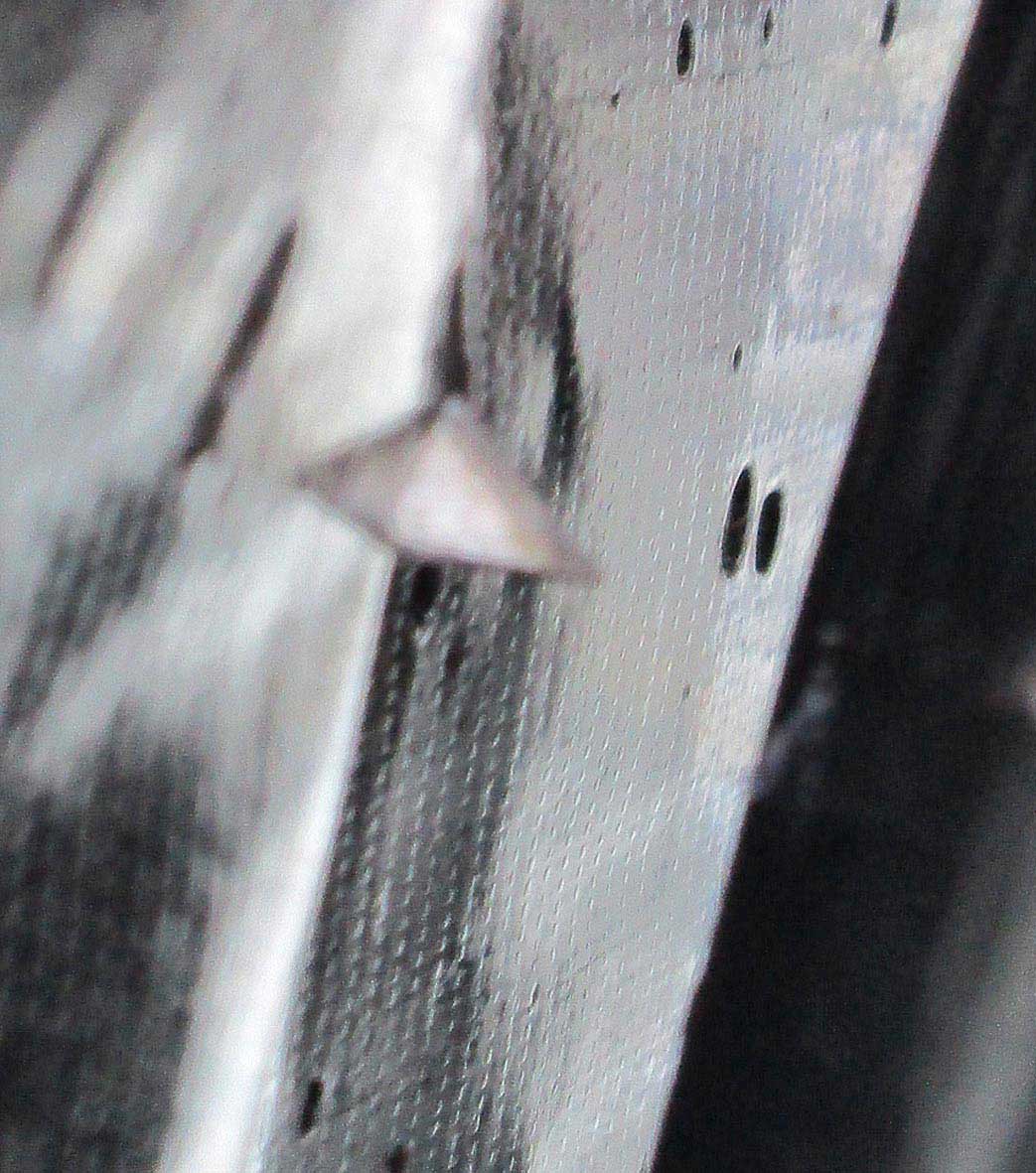 |
|||||||
|
above: Hrm, I had hoped for more, considering this thing can skin a car roof like a sardine can (if for some inexplicable reasons you donīt want to smash a window to get in). During the last years so- called “tactical tomahawks” (whose shapes do more resemble naval boarding axes or firemenīs breaching tools than indian hatchets) have grown more and more popular. Although the descendants of their inventors (northern american natives) are still around today, the hawkīs original use as a general utility tool/ weapon at hand has been forgottten (even if there ever was a “way of the tomahawk”). Nevertheless martial artists from all around the world have nowadays incorporated hatchets in their respective fighting styles and when you overcome your prejudices and find out what can be done with them youīll be surprised and in some cases shocked. So how would a small fighting axe look today? |
||||||||
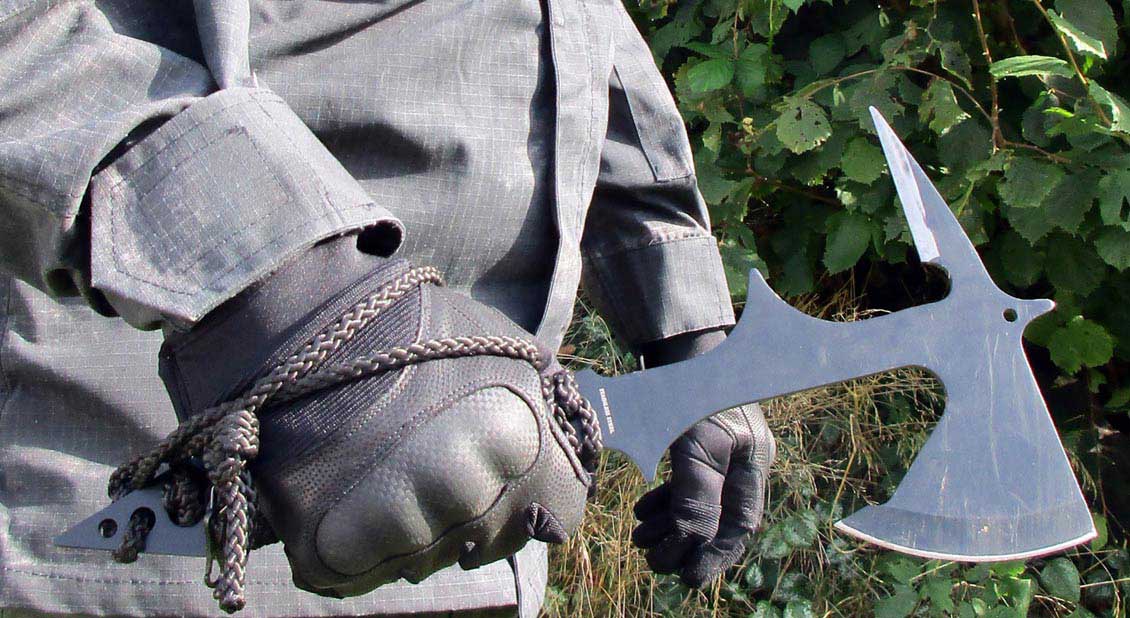 |
||||||||
 |
||||||||
|
The hatchet shown above is sold under various names by different wholesellers. Here it is distributed by Magnum (= the budget line of Böker) and United Cutlery as “Black Ronin”. Its extraordinary spikiness proclaims its purpose as something much more than a camp axe: there are videos where it is thrown quite accurately, but when you compare it with historical throwing axes (“franzisca”), it becomes clear that the designer either had fantasy allusions or something else in mind. On this one the originally dull spike has been sharpened and the inadequate handle wrapping has been replaced with something more suitable. Just under 40 cm long but weighing under 500 gr- that is light and fast. The spike (which is more a thorn) and the back- pointing tip of the beard together with the 4 other blunt spikes (no need to sharpen them, they work ok that way) make it perfect for striking, thrusting, blocking, hooking and slashing. The only drawback of my “Ronin” is that it is made from “only” 420 stainless steel (thatīs ok, but there are better ones) and that itīs not made from one piece- it has a welding scar under the grip-wrapping. These features make for its low price however in my opinion they render it unfit for continuous use. But letīs face it: if I get into a fight where I have to use this hatchet and I survive the experience and it stays intact Iīll gladly retire it and give it a place of honour above the mantelpiece, then buy a new one. Ok Alex: calm down, quit the macho- talk and have a look at the real world: DO NOT hold a hatchet like this ready for personal defense purposes. And know what? The judge is right to ask you this. Nobody forbids you to defend yourself, but youīre not allowed to use more force than necessary to stop the aggression or punish an attacker like you see fit. This precept is called “civilized behaviour” and itīs what the good guys do. And if you think it through, it even makes sense- everybody wants to live in a civilized society, for there always is somebody who is stronger than you and youīd be very unhappy if that guy had the “right to private warfare”. But leaving aside legal aspects; what did it do to the target? |
|
|
|
||||||||||||||||||||||||
|
which renders it practically unbendable but also twice as heavy. And while weīre at it letīs have a look at the different constructions of the hatchetīs spikes: Carnivoreīs massive triangular point has the edge to the front for easy levering the axe out of whatever it bit into by just pulling the handle. This “can-opener-principle” makes it almost impossible for the tool to get stuck. The thorn completely penetrated the targetīs both layers and stabbed about 3 cm into the padding. “Best” result so far! But in defense of my armour Iīm sure Ronin would punch a hole in metal, too. Iīll try that next year if I can somewhere aquire a cheap steel brestplate. However, to get on with this: What was feared by armoured warriors throughout the centuries were arrows. In the battle of Crécy (in 1346) british archers successfully fended off the attacks of french knights on horseback. Warfare was changed after that and cavallery charges lost much of their menace. A bowīs strength is measured in how much pounds (or lbs; 1 lb being 1,45 kg) the archer has to pull when drawing the bow. Wikipedia says that the average power of a longbow was about 80 pounds (36 kg, which is quite hard to draw), and everybody I talk to brags about knowing at least one guy owning a 100- pound- longbow (45 kg(!)- very hard to draw let alone aim true, which is the reason for the boasting). A modern sport bow draws “only” about 40 pounds, that would be 18 kg. Larp- bows around here have about 25 lbs (11 kg). below: This one for example draws 70 pounds (31 kg), which means the arrow is shot with... enough power to make a medieval longbowmen commander smile very broadly. |
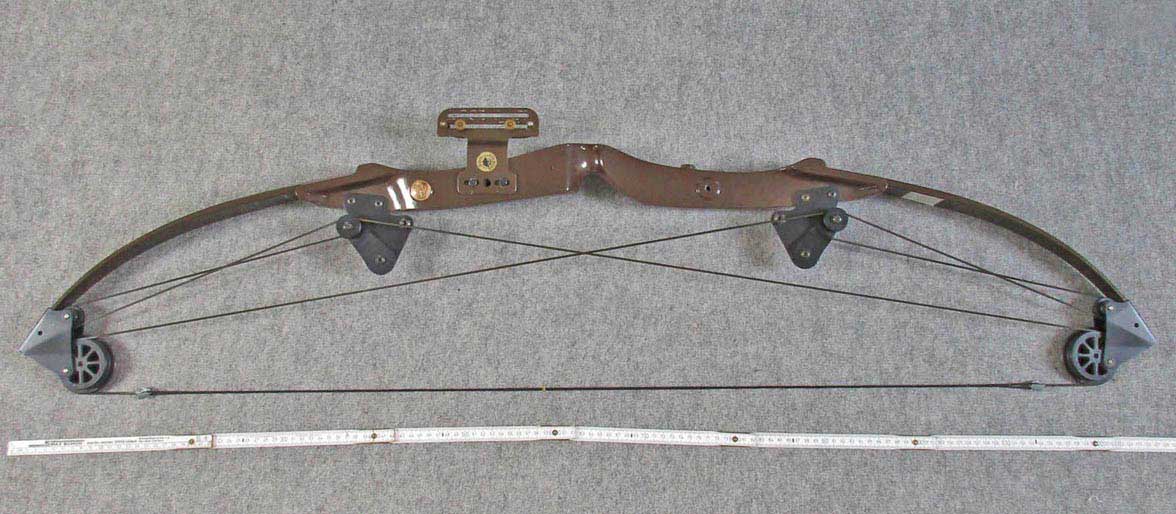 |
|||
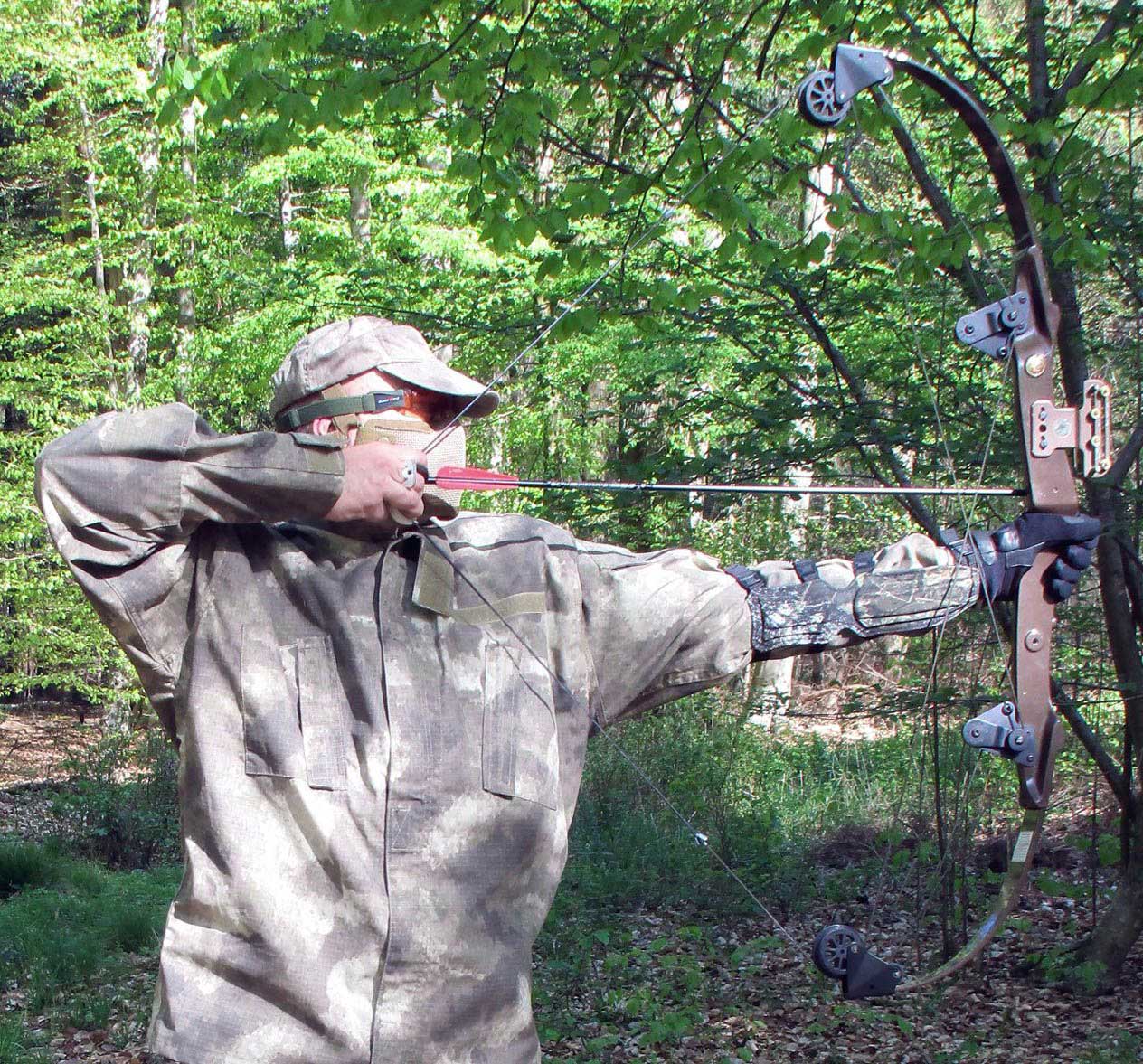 |
|||
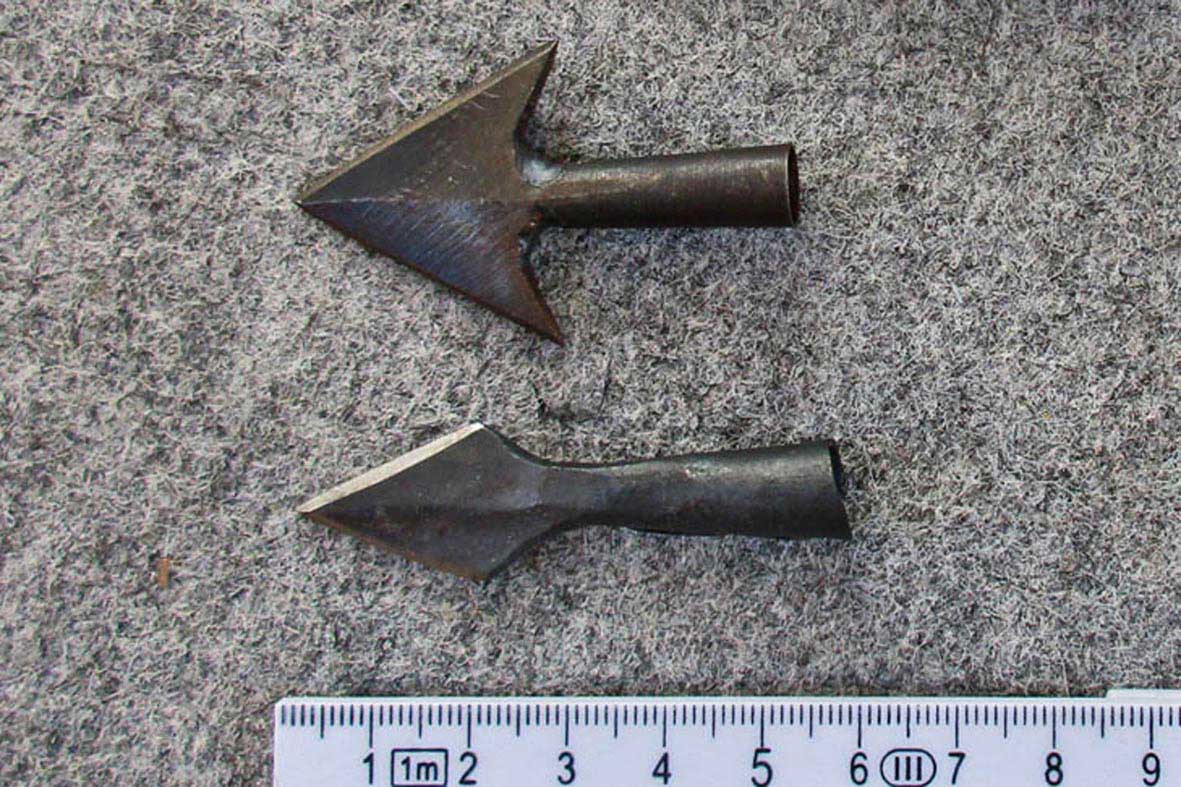 |
|||
|
Bear archeryīs “Whitetail Hunter” compound bow is no less than a legend. It also is about 30 years old. Big “Thanks” to the guys from “Archery Direct” in Hamburg who without even a raised eyebrow supplied perfect service and furnished the bow with a custom made new string (which seemed an appropriate measure before conducting the test). Nevertheless shooting a bow that old requires face-, eye- and hand- protection. The Whitetail has a special feature: its strength can be adjusted from 50 to 70+ pounds by aligning the wheeled levers over and under the handle. After trying a few shots with lesser power the bow performed flawlessly with the highest setting. Good work, Mr Bear. Arrows nowadays have “target- heads”. I aquired some iron warheads (see picture above on the right) and fitted them onto my test arrows; the broader one to the bow because its blade resembles the one professor Aldrete uses for shooting his partner with https://www.uwgb.edu/aldreteg/Linothorax.html . The arrowheads have sharp blades; not like a knife, but they can cut. Shooting distance is 7,5 metres, which is way too near for a bow but makes sure I hit where I want- after all Iīm not Legolas (who by the way seems to specialize in shooting the poor orks point- blank...). |
|
|
||||||||||||||||||||||||||
|
Interesting: I would have easily survived these hits. And I remember paintings of japanese warriors whose armours just bristle with arrows- obviously thereīs some truth in it. But what about the dead knights at Crécy? The top- warriors of their time gave their best but died. Maybe one should look for other mechanics than sheer penetrating power... Mind you, there were vast quantities of arrows in the air that day- perhaps the men (and/ or horses) were hit in spots not sufficiently covered by armour. This however is speculation Iīm not qualified for. So back to topic: Another weapon was renowned and feared for its power even more than a bow: the crossbow. Altough having lesser range, it packs more punch. The one below for example draws 175 lbs (= 79 kg). Ever heard about the Barnett “Commando”? |
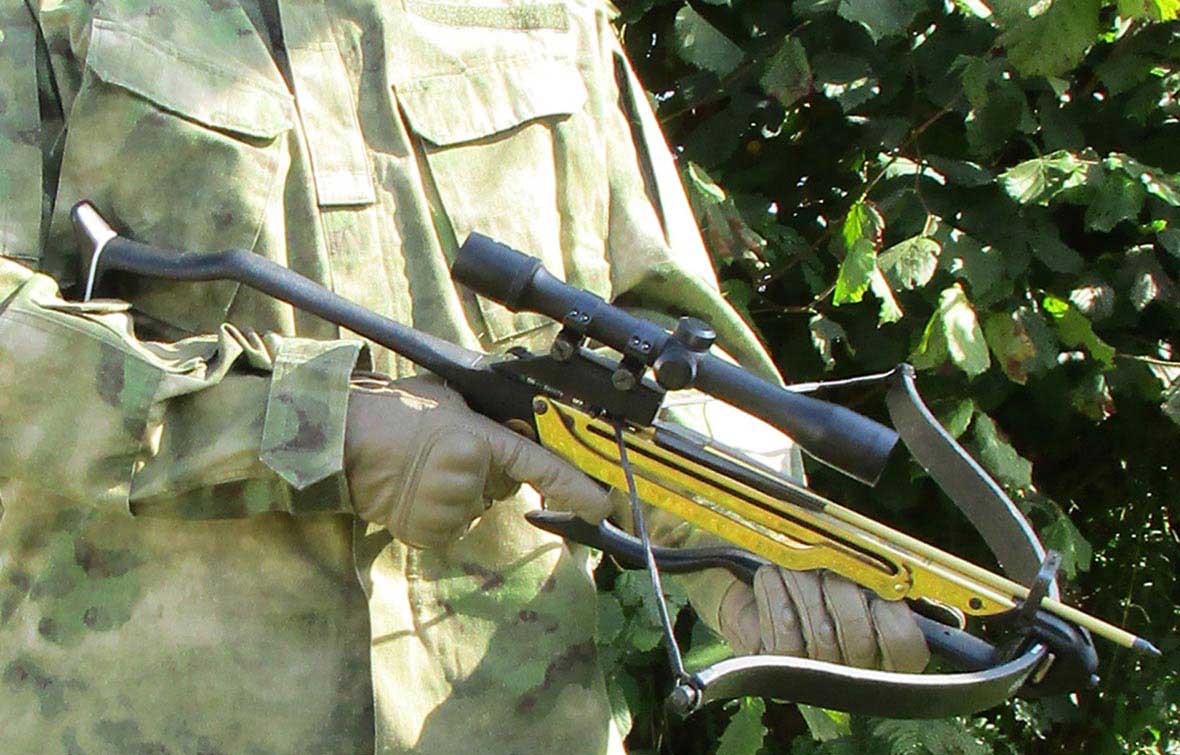 |
|||
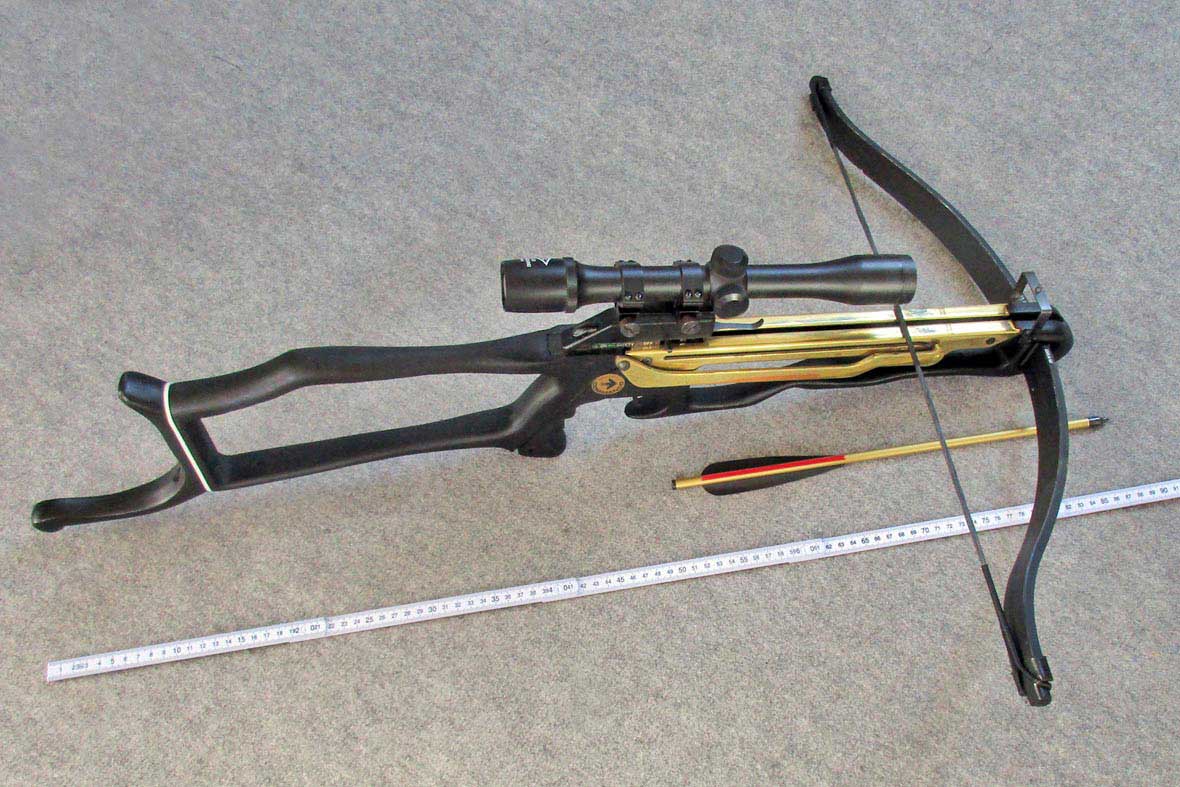 |
|||
|
You might have seen it on the movie poster of “For your eyes only” where Bond was threatened with it (although they didnīt get him of course). The movie is from 1981, which means this crossbow also is from the last millenium. The Commando by the way has the highest “rate of fire” in this class of crossbows because of its unique cocking mechanism: the shoulder rest folds down making two angled hooks grab the string, thus effortlessly levering it back into the “ready”-position in 6 seconds. Iīm just realising weīve had no warning notice for a while, so Iīll compensate that with pooling a few of them here: - never ever “dry-fire” a bow or crossbow (i.e. donīt release the string without an arrow) |
|
|
|
||||||||||||||||||||||||
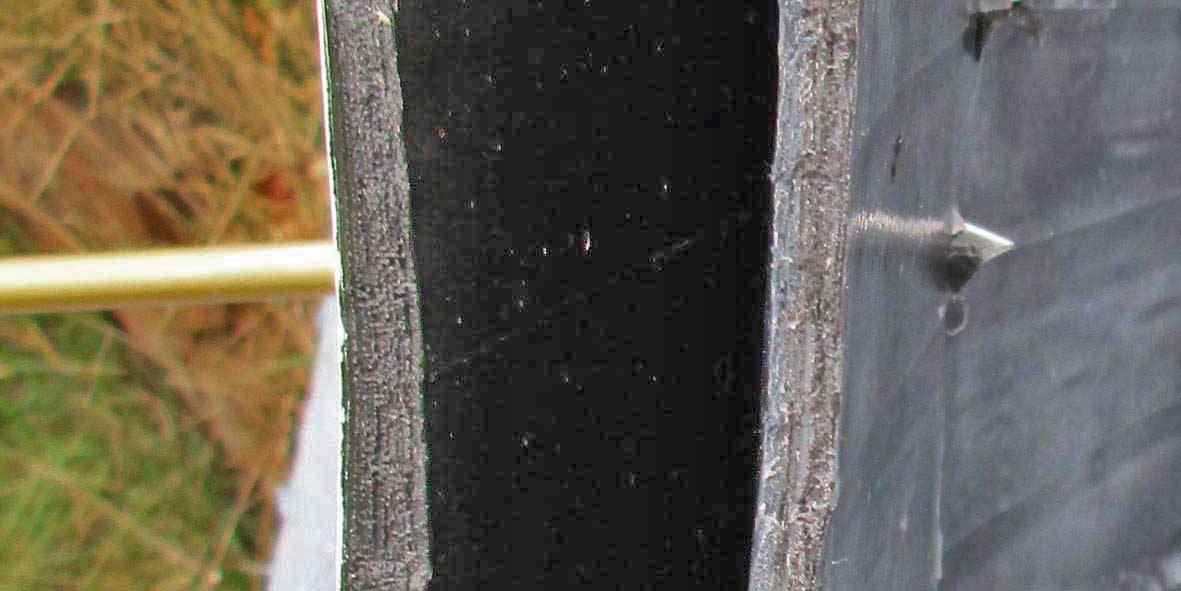 |
|
above and below: but the warhead punched through both layers, coming out in the padding about a centimetre, thus scoring second best result. The armourīs owner (i.e. me) although again would have survived the hit. |
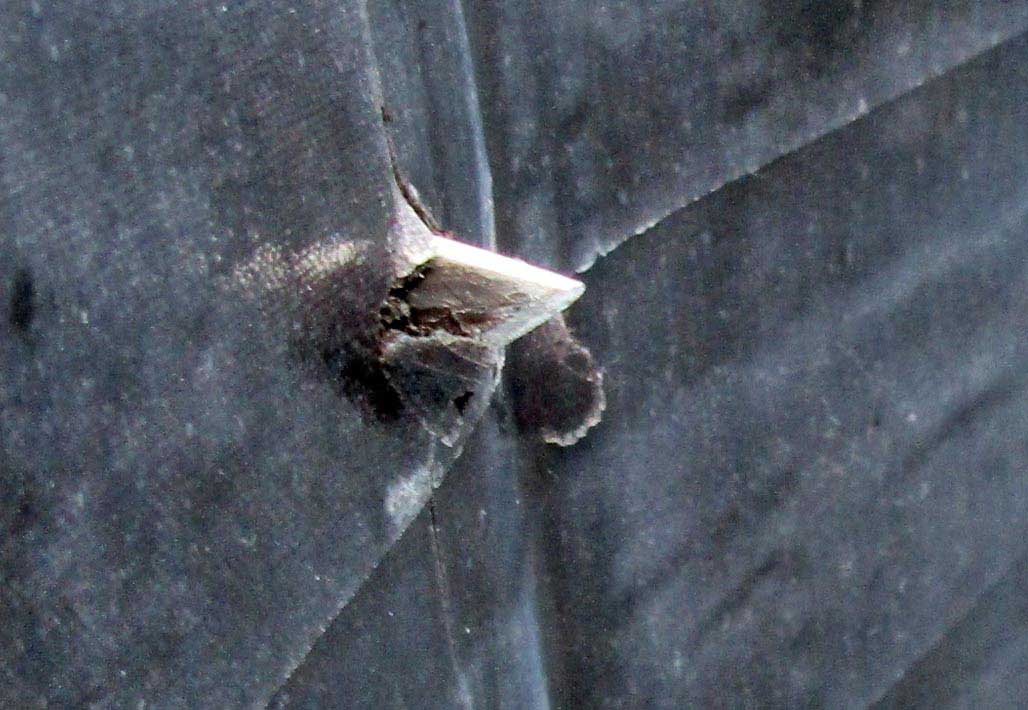 |
|||
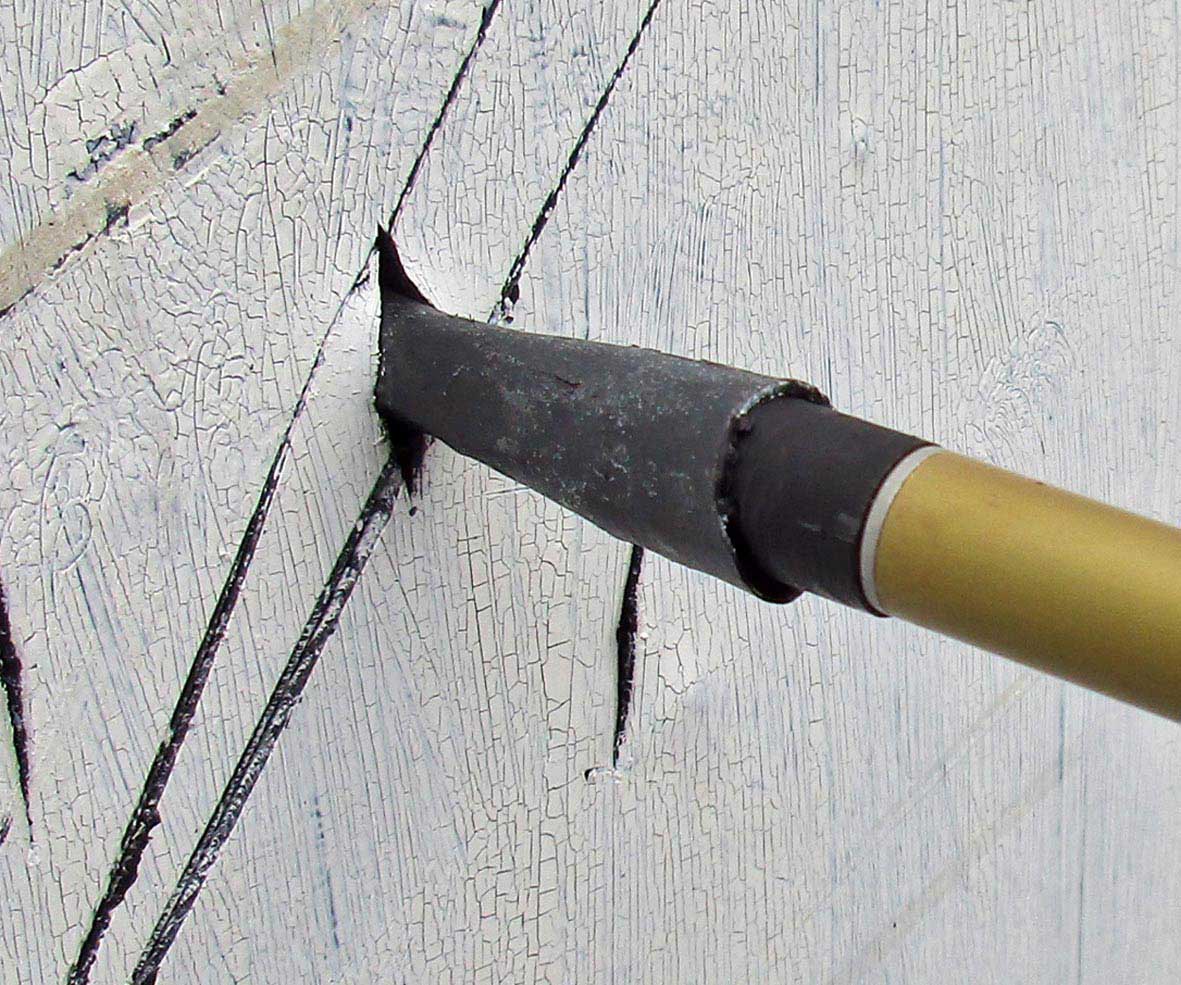 |
|||
|
|
|
But to wrap this thing up: How many layers of cloth make functionable armour? 10 layers of cotton linen will protect against cuts and hits even with sharp blades (suitable construction and sufficient padding assumed), but slashes and stabs will not reliably be deflected. 20 layers is what Iīd call trustworthy, also against arrows; but avoid being hit by armour- piercing strike- tools at all cost (ok, if possible avoid being hit at all). However 20 layers of the kind of cotton linen I use cannot be cut with plate shears any more (for trimming and carving out the desired shape), which is why I came up with the two- layer- construction (what construction? This construction: linothorax armour ). And can a battle- damaged Linothorax be repaired? Yes, even much more easily than metal armour. Just fill the cuts with glue and stick a patch of cloth over the “scar”.
So what was it again that this weapon- chitchat has to do with larp? Itīs the material the target is composed of. Of course in larp there are neither real weapons nor fighting- techniques, but the playerīs suits of armour have to be the genuine thing. And the question is: does cloth/ glue- composite qualify as a suitable material for armour or does it only qualify for depicting armour like foam or thin sheet metal or normal leather? Hopefully this was answered here to everybodyīs convenience: Like everything selfmade... it depends. But I like to know that it indeed is possible to manufacture functionable armour from nothing but cloth and glue. Which was well worth the effort. Iīve been asked for this test for almost a year and am happy to be able to conduct it now- thanks to everybody who lent equipment and trusted me with the (in some cases expensive or irreplacable) pieces. Normally one would now have to compare these results with the same tools used against metal and leather armour or reinforce the target with metal and try again... perhaps next year.
And now weīre really through here. If you build composite armour for yourself, Iīd like to hear from your experiences (mail to alex@larp-monsterbau.de). Train hard with guys who are better than you- but donīt play with real weapons; somebody will get hurt if you do. There is no exception from this rule. oct 2016, edited about 40 times. Thanks for your feedback and input, īpreciate it. |
| [Home] [Deutsch] [English] [about me] [whatīs new] [Contents] [about monsters] [faqs] [other sites] |
